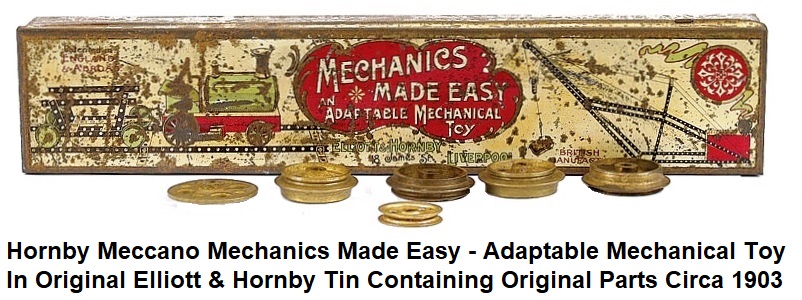 Hornby Railways was the leading brand of model railways for many years in the United Kingdom. Its
roots date back to 1901,
when company founder Frank Hornby (1863 - 1936) received a patent for his Meccano construction toy. Frank Hornby was
granted his patent and put the invention into production under the name ‘Mechanics Made Easy’. This construction set was renamed Meccano in 1907.
This led to the establishment of Meccano Ltd in 1907. Initially the early sets were produced by Hornby himself. The success of the Meccano sets
required employing assistance from others in a small plant. Manufacturing moved to a 5 acre tract at Binns Road, Liverpool in 1914.
Meccano sets continued to catch on, and soon they were being marketed around the world. Hornby produced a railway game in 1915 called Raylo.
This game used a small tinplate clockwork locomotive. Players were required to operate a series of switches to prevent the locomotive from running off
the rails. Meccano production continued during the First World War, but at limited capacity.
Hornby Railways was the leading brand of model railways for many years in the United Kingdom. Its
roots date back to 1901,
when company founder Frank Hornby (1863 - 1936) received a patent for his Meccano construction toy. Frank Hornby was
granted his patent and put the invention into production under the name ‘Mechanics Made Easy’. This construction set was renamed Meccano in 1907.
This led to the establishment of Meccano Ltd in 1907. Initially the early sets were produced by Hornby himself. The success of the Meccano sets
required employing assistance from others in a small plant. Manufacturing moved to a 5 acre tract at Binns Road, Liverpool in 1914.
Meccano sets continued to catch on, and soon they were being marketed around the world. Hornby produced a railway game in 1915 called Raylo.
This game used a small tinplate clockwork locomotive. Players were required to operate a series of switches to prevent the locomotive from running off
the rails. Meccano production continued during the First World War, but at limited capacity.
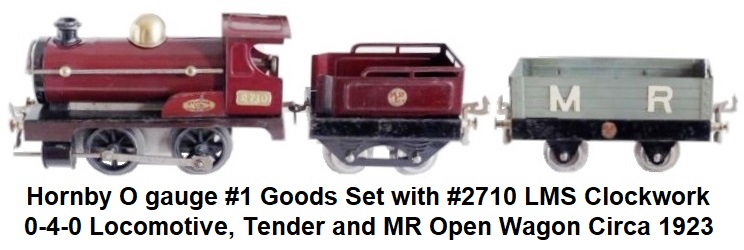 After the war ended in 1918, Germany was out of favor and consumers avoided purchasing the toys that the German craftsmen had famously produced before the war.
As a way to fill the gap in the toy train market, Frank Hornby the maker of Meccano, started to produce 'O' gauge tinplate trains under his own name.
Hornby, and his Meccano Ltd, based in Liverpool, released its first train, a clockwork 'O' gauge
(1:48) model, in 1920. Hornby's first model railroad set was made to go with the Meccano construction sets.
This train set consisted of an 0-4-0 steam outline locomotive with a 4-wheeled tender and two 4-wheeled freight vans.
It was simply called the Hornby Clockwork Train. Hornby Trains were powered by a high quality clockwork motor, made of metal
pressings held together by Meccano nuts and bolts. The Hornby Clockwork Train was designed to be taken apart and put
back together, just like the construction sets. These early Hornby model trains were made of nickel-based plates that were richly
painted in stove-enamel black and trimmed with brass, so they were very attractive model railroad sets. This feature, and the all-British manufacture,
allowed the trains to be sold at a premium over the price of foreign competitors, to a loyal and enthusiastic public who knew and trusted the
Meccano name. The Hornby Tinprinted Train followed shortly after. This was a cheaper and more conventionally lithographed sheet metal product.
Bing apparently provided Hornby some assistance in the earliest production days as some Hornby Tinprinted sets have shown up with
the cars bearing a Bing trademark.
After the war ended in 1918, Germany was out of favor and consumers avoided purchasing the toys that the German craftsmen had famously produced before the war.
As a way to fill the gap in the toy train market, Frank Hornby the maker of Meccano, started to produce 'O' gauge tinplate trains under his own name.
Hornby, and his Meccano Ltd, based in Liverpool, released its first train, a clockwork 'O' gauge
(1:48) model, in 1920. Hornby's first model railroad set was made to go with the Meccano construction sets.
This train set consisted of an 0-4-0 steam outline locomotive with a 4-wheeled tender and two 4-wheeled freight vans.
It was simply called the Hornby Clockwork Train. Hornby Trains were powered by a high quality clockwork motor, made of metal
pressings held together by Meccano nuts and bolts. The Hornby Clockwork Train was designed to be taken apart and put
back together, just like the construction sets. These early Hornby model trains were made of nickel-based plates that were richly
painted in stove-enamel black and trimmed with brass, so they were very attractive model railroad sets. This feature, and the all-British manufacture,
allowed the trains to be sold at a premium over the price of foreign competitors, to a loyal and enthusiastic public who knew and trusted the
Meccano name. The Hornby Tinprinted Train followed shortly after. This was a cheaper and more conventionally lithographed sheet metal product.
Bing apparently provided Hornby some assistance in the earliest production days as some Hornby Tinprinted sets have shown up with
the cars bearing a Bing trademark.

 Right from the first, surprisingly large quantities of the trains
were made and sold, helped greatly by Meccano Ltd.'s existing network of dealers and by promotions in the widely read Meccano Magazine.
Meccano Hornby Trains were an instant success and the company was
quick to introduce more engines and accessories. The #2 locos and bogie passenger coaches were introduced in 1921. They
now carried a monogram, 'M LD L', located either on the smoke-box or underneath the cab.
1922 saw the introduction of new wagons including timber wagons, a Shell Petrol tank wagon, two different brake vans, a cement
wagon and a gunpowder van. New rails and a buffer stop were also released. The Zulu Trains (later to become the #0 range) were also produced.
These trains were similar to the regular Hornby Trains with a high gloss finish but were not constructional. The nuts-and-bolts approach was dropped in favor of the more
conventional tabbed and riveted construction, but the Meccano method was still used on some early Hornby accessories, namely the famous lattice bridge,
and some of the early wagons. The Zulu Tank Loco developed into a best seller. Since it was becoming clear that the Meccano-style nuts and bolts construction
idea wasn't that important to customers, and phasing it out meant losing one of the main distinguishing features between the Hornby and Zulu brands, Meccano Ltd
decided to merge the contents of both ranges into a single range called Hornby Trains. The original monogram was discontinued, and
the Hornby name now appeared on the smokebox door on most of the locomotives. On the smaller, less expensive types, the name Hornby appeared on the cab-sides.
Great emphasis was placed on the quality of materials, paint and finish.
At the same time, the less expensive line of Tinprinted trains that had been created was now just an unimaginative copy of a German product. It was failing
to sell as well in the marketplace however, despite being less costly.
Right from the first, surprisingly large quantities of the trains
were made and sold, helped greatly by Meccano Ltd.'s existing network of dealers and by promotions in the widely read Meccano Magazine.
Meccano Hornby Trains were an instant success and the company was
quick to introduce more engines and accessories. The #2 locos and bogie passenger coaches were introduced in 1921. They
now carried a monogram, 'M LD L', located either on the smoke-box or underneath the cab.
1922 saw the introduction of new wagons including timber wagons, a Shell Petrol tank wagon, two different brake vans, a cement
wagon and a gunpowder van. New rails and a buffer stop were also released. The Zulu Trains (later to become the #0 range) were also produced.
These trains were similar to the regular Hornby Trains with a high gloss finish but were not constructional. The nuts-and-bolts approach was dropped in favor of the more
conventional tabbed and riveted construction, but the Meccano method was still used on some early Hornby accessories, namely the famous lattice bridge,
and some of the early wagons. The Zulu Tank Loco developed into a best seller. Since it was becoming clear that the Meccano-style nuts and bolts construction
idea wasn't that important to customers, and phasing it out meant losing one of the main distinguishing features between the Hornby and Zulu brands, Meccano Ltd
decided to merge the contents of both ranges into a single range called Hornby Trains. The original monogram was discontinued, and
the Hornby name now appeared on the smokebox door on most of the locomotives. On the smaller, less expensive types, the name Hornby appeared on the cab-sides.
Great emphasis was placed on the quality of materials, paint and finish.
At the same time, the less expensive line of Tinprinted trains that had been created was now just an unimaginative copy of a German product. It was failing
to sell as well in the marketplace however, despite being less costly.
 The merging of the Hornby and Zulu brands meant that Meccano Ltd now had versions of tender and tank locos at different price points,
and decided to implement a tiered pricing system reminiscent of the numbered Meccano sets, whereby the default version of an item was the #1, the more
expensive aspirational version was the #2, and a cut-down version would be the #0. The #1 locos were standard 4-wheeled 0-4-0 engines based on the
original Hornby Clockwork Train, the #2 locos were bigger with more wheels, and more numbers were added to the system as the sophistication (and cost)
increased, along with enhanced special variants. As the #1 and #0 locos continued to be developed and improved, it sometimes became quite difficult to
tell them apart. The numbering also applied to accessories - the #1 Signal Cabin had solid tin windows and a printed staircase, but the #2 had punched-through
open windows, physical stairs on one side, and a hinged back to allow it to be fitted with the Hornby Control System. A further separate range of entry-level
pieces and sets aimed at younger children was introduced as the M Series. The M Series locos were the descendants of the Tin Printed Train, were lithographed
rather than enameled, and the locos and their coaches had different couplings to the standard range. The M Series then ended up spawning even more variations
(like separate M0 and M1 locos), in an attempt to make sure that the Hornby range had products to meet as many potential buyers' budgets as possible.
The merging of the Hornby and Zulu brands meant that Meccano Ltd now had versions of tender and tank locos at different price points,
and decided to implement a tiered pricing system reminiscent of the numbered Meccano sets, whereby the default version of an item was the #1, the more
expensive aspirational version was the #2, and a cut-down version would be the #0. The #1 locos were standard 4-wheeled 0-4-0 engines based on the
original Hornby Clockwork Train, the #2 locos were bigger with more wheels, and more numbers were added to the system as the sophistication (and cost)
increased, along with enhanced special variants. As the #1 and #0 locos continued to be developed and improved, it sometimes became quite difficult to
tell them apart. The numbering also applied to accessories - the #1 Signal Cabin had solid tin windows and a printed staircase, but the #2 had punched-through
open windows, physical stairs on one side, and a hinged back to allow it to be fitted with the Hornby Control System. A further separate range of entry-level
pieces and sets aimed at younger children was introduced as the M Series. The M Series locos were the descendants of the Tin Printed Train, were lithographed
rather than enameled, and the locos and their coaches had different couplings to the standard range. The M Series then ended up spawning even more variations
(like separate M0 and M1 locos), in an attempt to make sure that the Hornby range had products to meet as many potential buyers' budgets as possible.
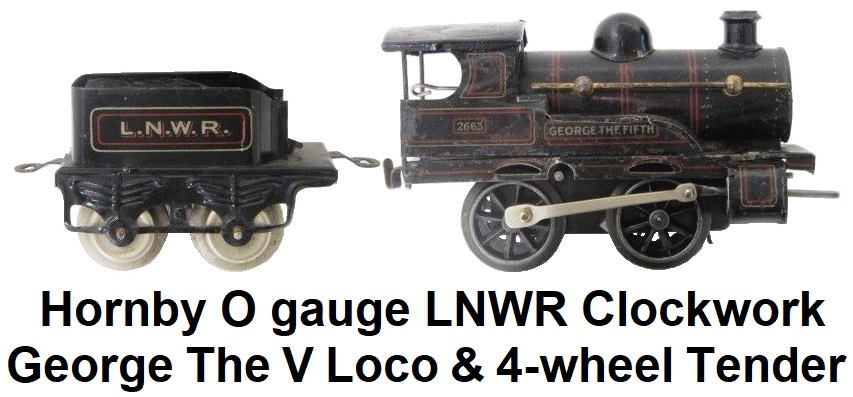 One of the earliest Hornby locomotives was the M-3. In its first design, it was done in LNWR black, and bore the name 'George Fifth',
in honor of the then-King George V. Then later, a slight modification about the foot-plate was made. At the time of the grouping of the British Railways in 1923
the Hornby model appeared in black for freight trains, and in red or green for use in LMS or GWR passenger sets.
By 1923 LMS and LNER liveries began to replace LNWR, MR, GN, CR, GE, and LBSC on Hornby product being produced for the UK market. Trains produced for the
French market continued to bear PLM, Nord and Etat markings. A well-proportioned #2 Tank Locomotive was made available. Many new wagons were sold, including the
short-lived Colman's Mustard Van. New accessories included the Windsor Station.
One of the earliest Hornby locomotives was the M-3. In its first design, it was done in LNWR black, and bore the name 'George Fifth',
in honor of the then-King George V. Then later, a slight modification about the foot-plate was made. At the time of the grouping of the British Railways in 1923
the Hornby model appeared in black for freight trains, and in red or green for use in LMS or GWR passenger sets.
By 1923 LMS and LNER liveries began to replace LNWR, MR, GN, CR, GE, and LBSC on Hornby product being produced for the UK market. Trains produced for the
French market continued to bear PLM, Nord and Etat markings. A well-proportioned #2 Tank Locomotive was made available. Many new wagons were sold, including the
short-lived Colman's Mustard Van. New accessories included the Windsor Station.
Hornby O gauge Tinplate Coach Stock
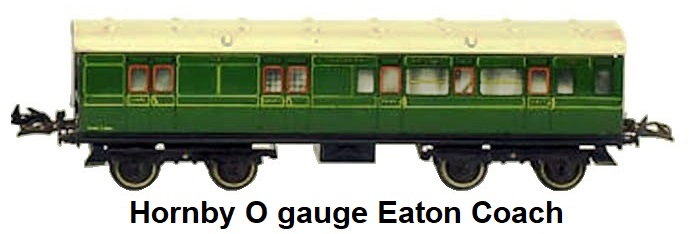
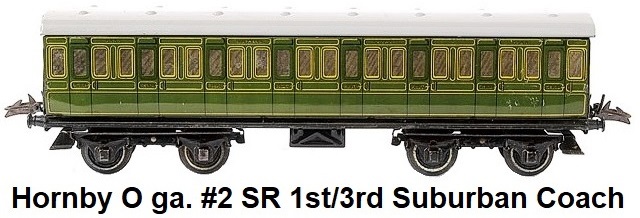
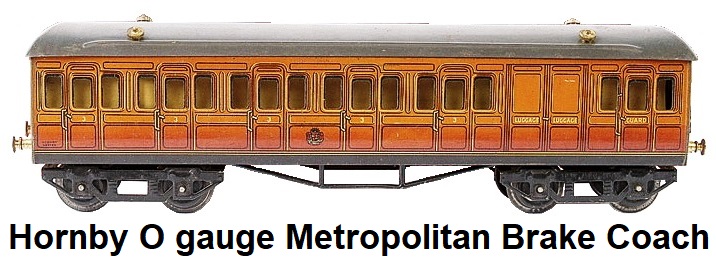
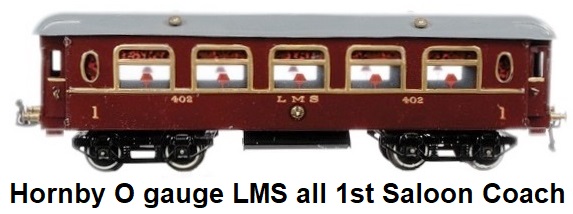
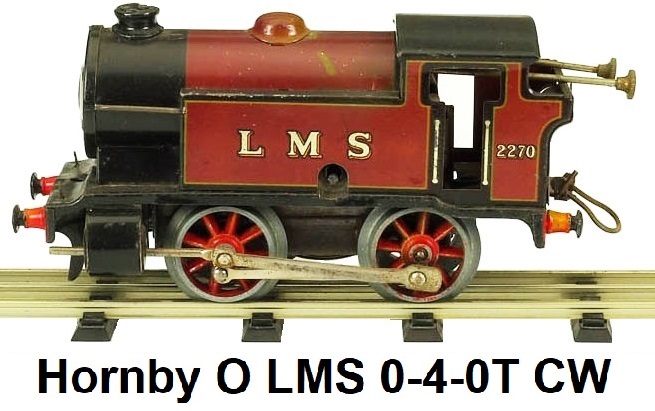 An electric train, a version of the #2 Pullman Train was briefly sold but was under-designed and the few that were made were
only sold in France. In 1924 there was another expansion in the range, with the Snowplow, the Carr's, Crawford's and Jacob's Biscuit Vans and
Seccotine Van, together with some fine accessories, such as the Tunnel. At this point in time the first use
of tab and slot assembly in the manufacturing process was employed and the Hornby Series name is adopted and used on packaging.
In 1925 a much more successful electric model was introduced, operating on high
voltage (220-240V) AC power. Introduction of electric trains led to the abandonment of all sales and marketing approaches around Hornby trains being
a constructional item. Safety concerns saw low voltage 4V and then 6V motors introduced, followed by a
reliable 20V AC system, which was developed in the early 1930's. However, clockwork remained the mainstay of
the Hornby 'O' gauge trains until 1937. Coach and passenger stock were made of lithographed sheet metal. The actual designers of Hornby Trains are
unknown, but contributors included Frank Hornby, Donald Smith and Ronald C. Wyborn.
An electric train, a version of the #2 Pullman Train was briefly sold but was under-designed and the few that were made were
only sold in France. In 1924 there was another expansion in the range, with the Snowplow, the Carr's, Crawford's and Jacob's Biscuit Vans and
Seccotine Van, together with some fine accessories, such as the Tunnel. At this point in time the first use
of tab and slot assembly in the manufacturing process was employed and the Hornby Series name is adopted and used on packaging.
In 1925 a much more successful electric model was introduced, operating on high
voltage (220-240V) AC power. Introduction of electric trains led to the abandonment of all sales and marketing approaches around Hornby trains being
a constructional item. Safety concerns saw low voltage 4V and then 6V motors introduced, followed by a
reliable 20V AC system, which was developed in the early 1930's. However, clockwork remained the mainstay of
the Hornby 'O' gauge trains until 1937. Coach and passenger stock were made of lithographed sheet metal. The actual designers of Hornby Trains are
unknown, but contributors included Frank Hornby, Donald Smith and Ronald C. Wyborn.
Early Hornby 'O' gauge Freight Wagons Circa 1925
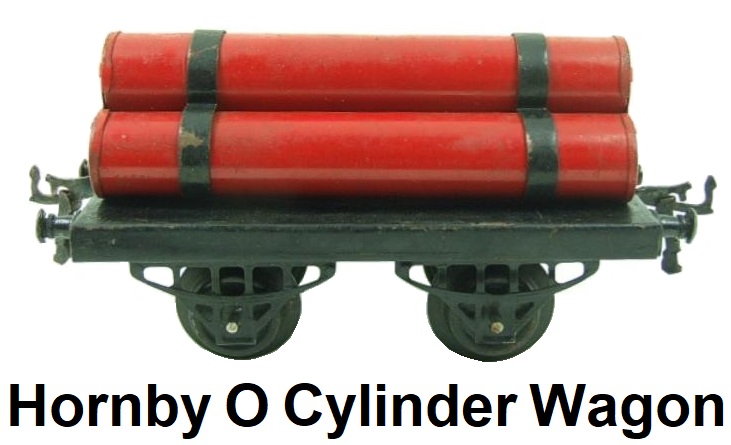
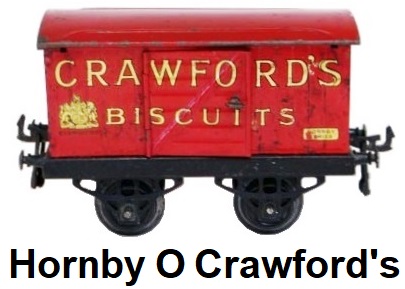
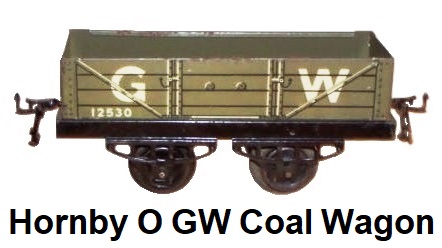
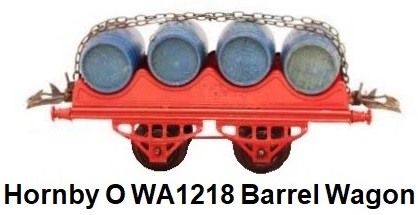
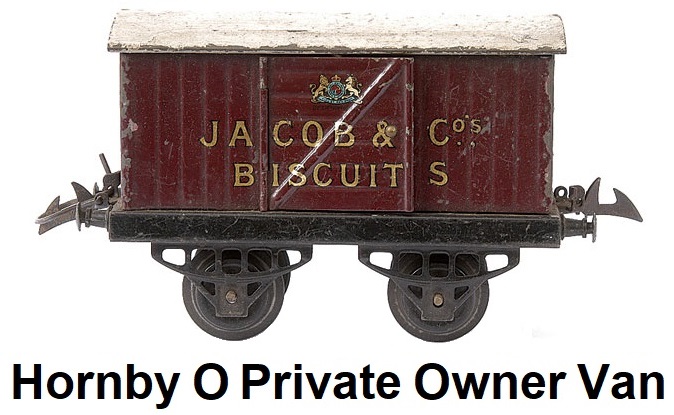
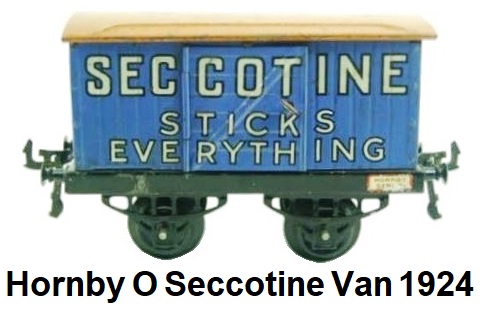
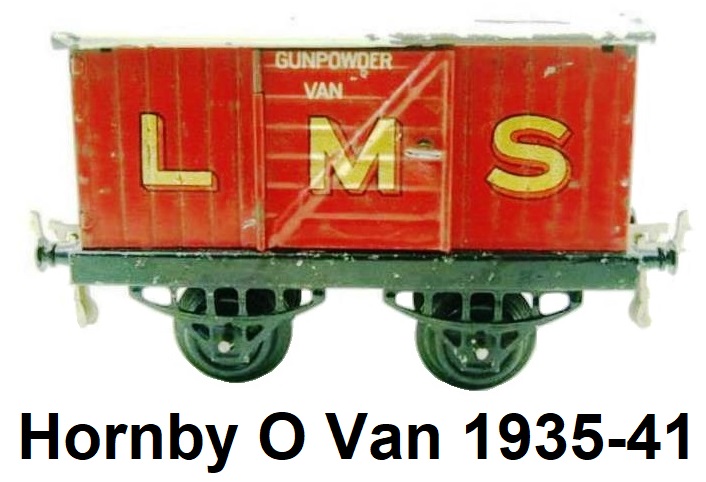

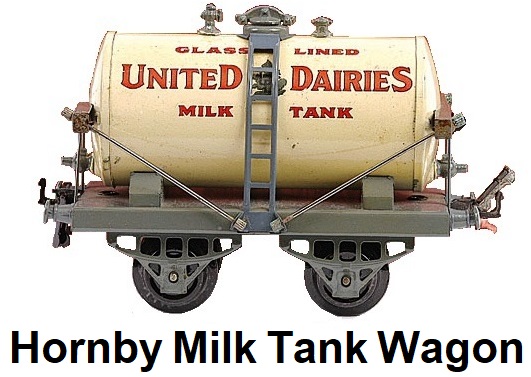
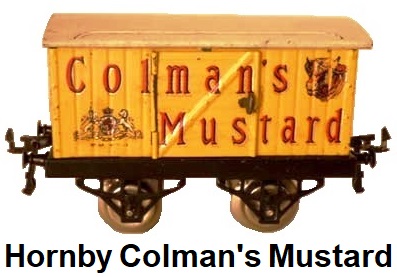
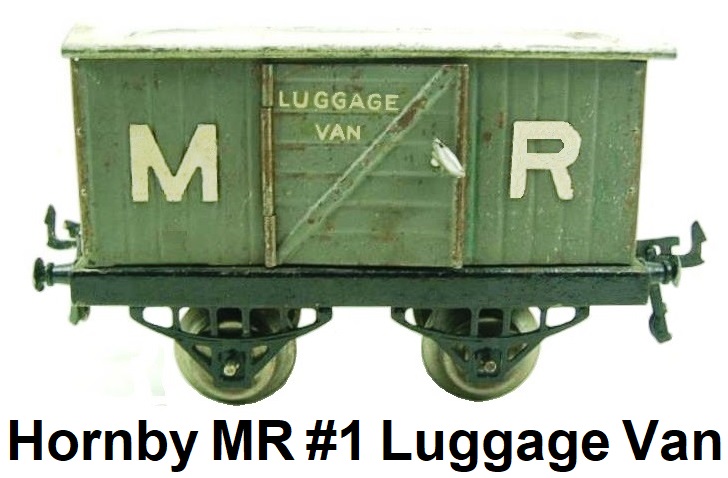
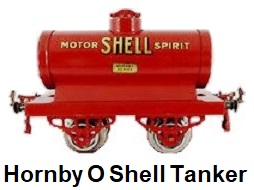
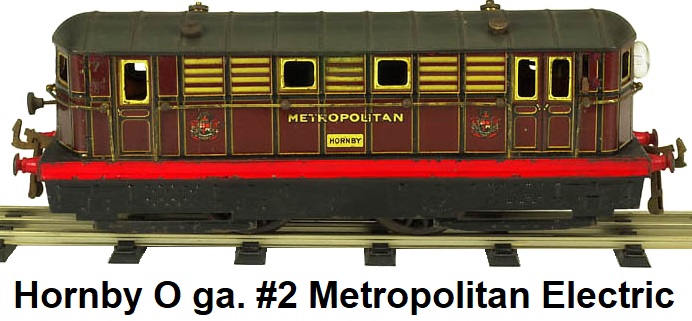 Hornby's first electric models were the high voltage 'Metropolitan' type, modeled
after the London Metropolitan Railway locomotives. The initial Hornby model had only four wheels (2 axles) instead of
twin bogies as appeared on the prototypes. This set was modeled after the Metropolitan Railway, London's first passenger subway,
so Hornby's first electric train represented a real-life electric train. High voltage trains are now regarded as dangerous in the hands of youngsters,
but in the 1920's such things were accepted. Light bulbs were placed in the circuit to facilitate speed control. The gauge of Hornby trains
was approximately 32mm, although this varied somewhat over the years. These were toy trains and no train in the Hornby 'O' gauge Series was a true scale
model, although the true-to-type #2 Special locos were not far from 7mm to the foot. The bogie coaches had to be short, because of the
restricted 2 foot (60cm) radius of most tinplate track.
Hornby's first electric models were the high voltage 'Metropolitan' type, modeled
after the London Metropolitan Railway locomotives. The initial Hornby model had only four wheels (2 axles) instead of
twin bogies as appeared on the prototypes. This set was modeled after the Metropolitan Railway, London's first passenger subway,
so Hornby's first electric train represented a real-life electric train. High voltage trains are now regarded as dangerous in the hands of youngsters,
but in the 1920's such things were accepted. Light bulbs were placed in the circuit to facilitate speed control. The gauge of Hornby trains
was approximately 32mm, although this varied somewhat over the years. These were toy trains and no train in the Hornby 'O' gauge Series was a true scale
model, although the true-to-type #2 Special locos were not far from 7mm to the foot. The bogie coaches had to be short, because of the
restricted 2 foot (60cm) radius of most tinplate track.
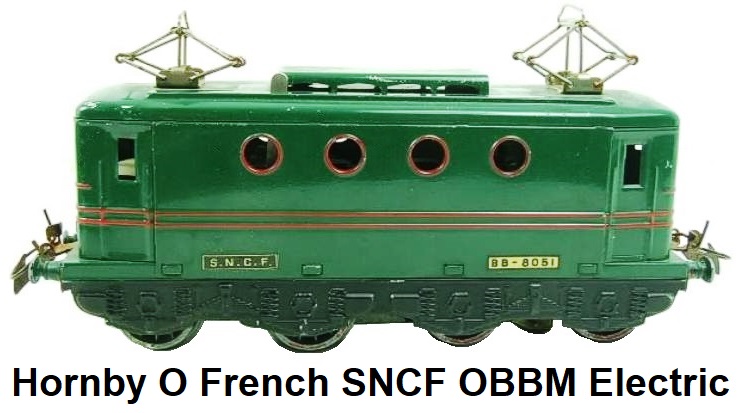
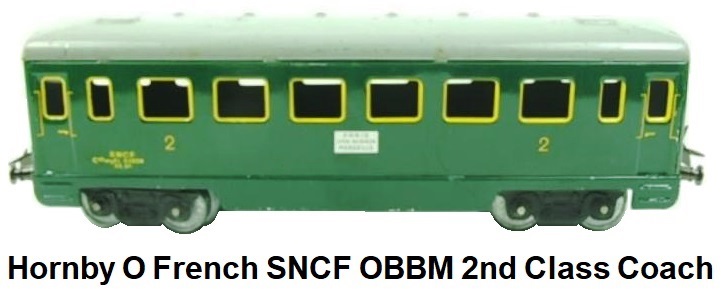
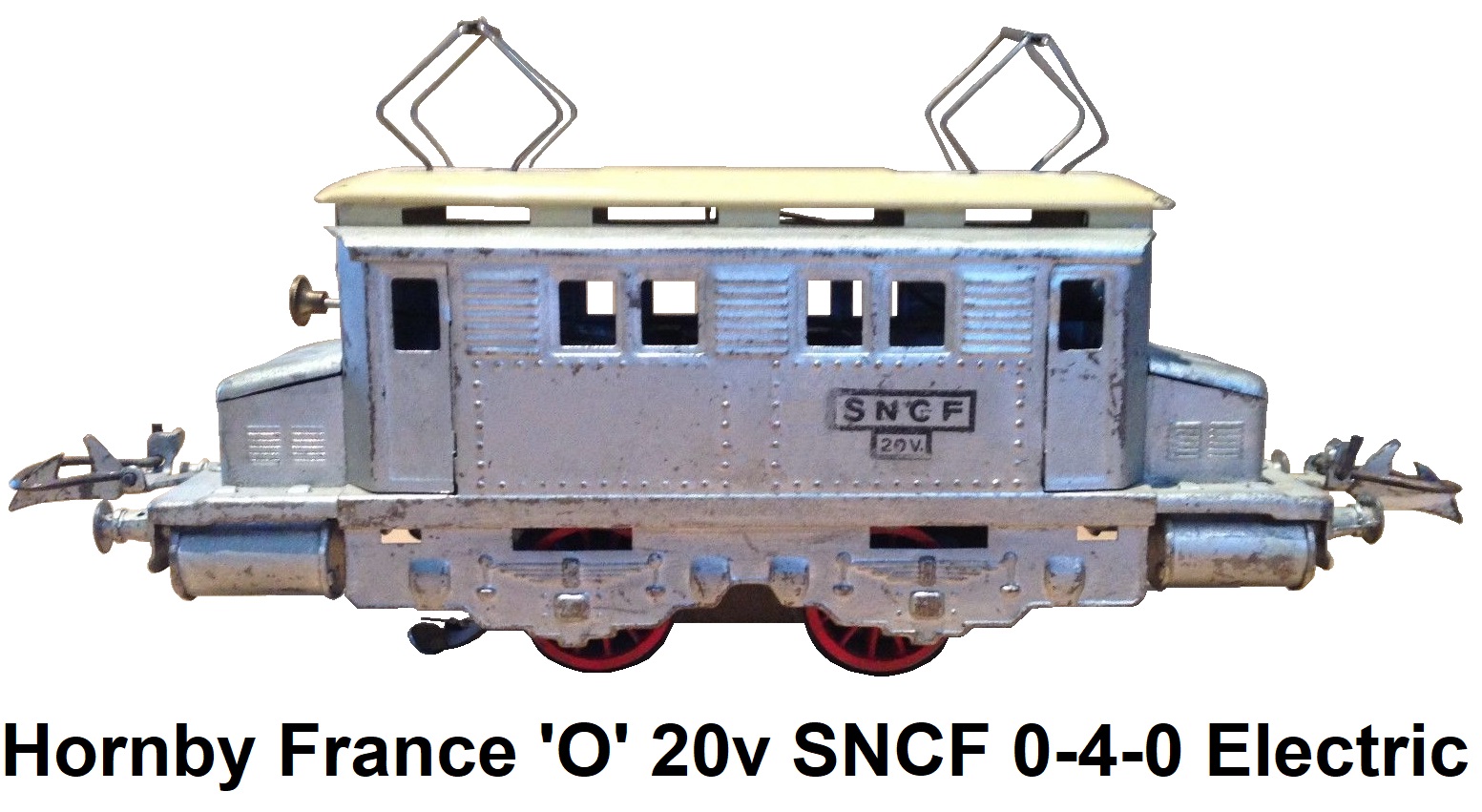
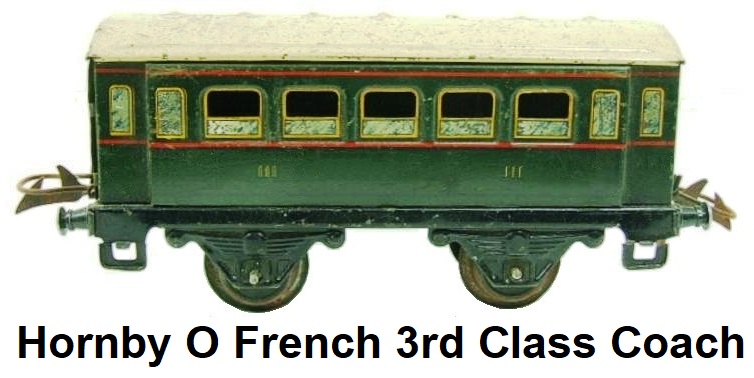
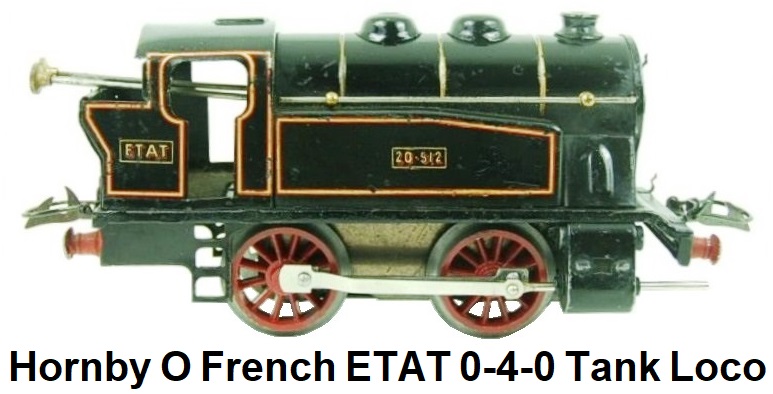
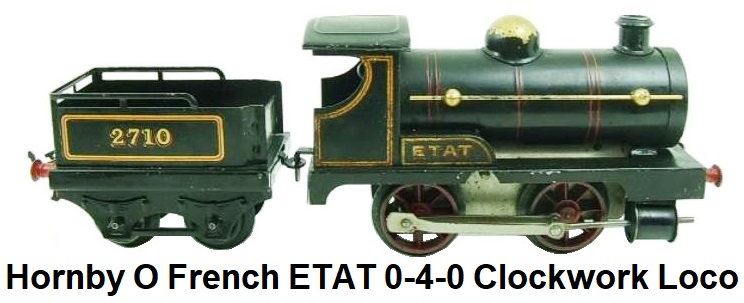
 A factory was established on Rue Rebeval in Paris, France, which developed its own range of French outline
trains. In 1926 the Riviera Blue Train (influenced by the important French market) featured the first of the imposing
4-4-2 #3 locomotives painted in Nord brown and gold livery. The Blue Train coaches, featuring eight-wheel dining
and sleeping cars in blue, were large and most impressive in appearance. Hornby Liverpool
dominated export activity elsewhere, with large numbers of Hornby trains exported to Australia, New Zealand,
Argentina and Scandinavia. Even though the export models were often painted in 'foreign' liveries, Hornby
trains looked very British. A new M series replaced the unsuccessful Tinprinted Trains. The smaller M line offered great play value.
The new Hornby Control System allowed control of clockwork trains, points and signals from a lever frame in the signal cabin. A Goods Depot, Island
and Passenger Platforms were also introduced in 1926. Great Western trains were also added to the range. 1927 saw the
introduction of a British range of clockwork and electric 4-4-2 locos named Flying Scotsman, Royal Scot and the first of the famous 'Castle' class
locos, the Caerphilly Castle, as part of the #3 loco product line. These were offered in sets together with new larger Pullman Coaches. The
Caerphilly Castle pulled the GWR Cornish Riviera set. The LMS Royal Scot set was hauled by the RS loco #6100. The LNER Flying Scotsman came with
the FS #4472 loco, and the SR Continental Express with the #850 Lord Nelson.
A factory was established on Rue Rebeval in Paris, France, which developed its own range of French outline
trains. In 1926 the Riviera Blue Train (influenced by the important French market) featured the first of the imposing
4-4-2 #3 locomotives painted in Nord brown and gold livery. The Blue Train coaches, featuring eight-wheel dining
and sleeping cars in blue, were large and most impressive in appearance. Hornby Liverpool
dominated export activity elsewhere, with large numbers of Hornby trains exported to Australia, New Zealand,
Argentina and Scandinavia. Even though the export models were often painted in 'foreign' liveries, Hornby
trains looked very British. A new M series replaced the unsuccessful Tinprinted Trains. The smaller M line offered great play value.
The new Hornby Control System allowed control of clockwork trains, points and signals from a lever frame in the signal cabin. A Goods Depot, Island
and Passenger Platforms were also introduced in 1926. Great Western trains were also added to the range. 1927 saw the
introduction of a British range of clockwork and electric 4-4-2 locos named Flying Scotsman, Royal Scot and the first of the famous 'Castle' class
locos, the Caerphilly Castle, as part of the #3 loco product line. These were offered in sets together with new larger Pullman Coaches. The
Caerphilly Castle pulled the GWR Cornish Riviera set. The LMS Royal Scot set was hauled by the RS loco #6100. The LNER Flying Scotsman came with
the FS #4472 loco, and the SR Continental Express with the #850 Lord Nelson.
|
Hornby 'O' gauge #2 And #3 Special Steam Outline Locomotives |
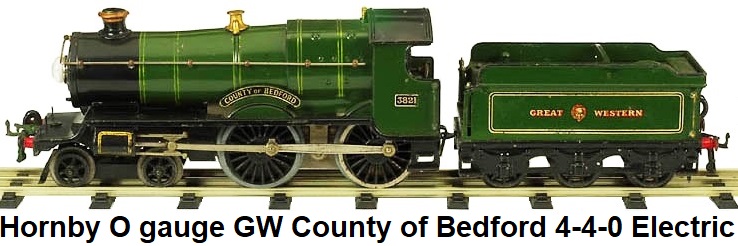 |
 |
 |
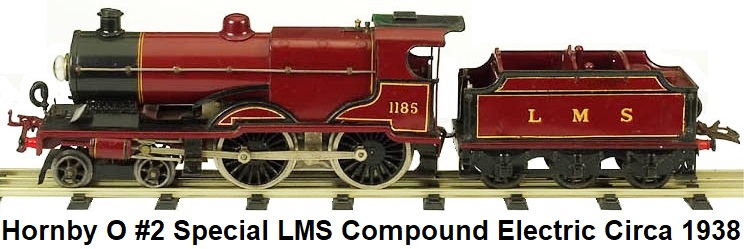 |
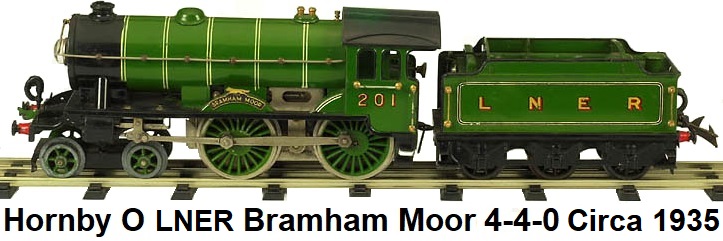 |
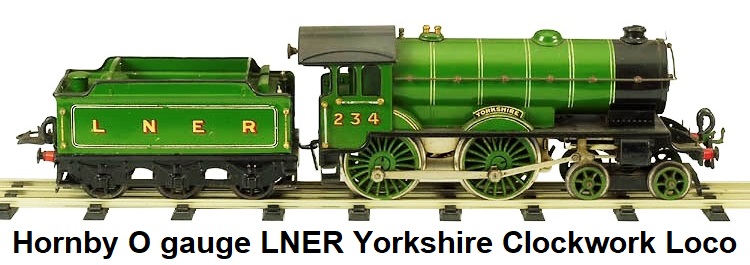 |
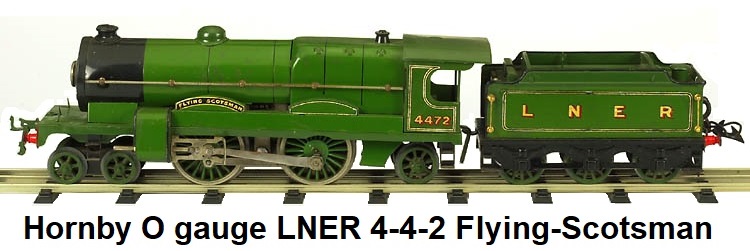 |
 |
 Hornby attempted to break into the American market by setting up a factory in 1927
in Elizabeth, New Jersey, to make American-style trains. These were colorful and attractive, but low market
and only clockwork. Sets consisted of a red or green American style 0-4-0 locomotive with 4-wheel tender, and 3
freight cars - a Penn Ry. box car, oil tank car and caboose in green litho. The passenger set was equipped with
two four-wheel Pullmans in green or yellow litho lettered either Washington or Madison.
They probably would have failed in the marketplace because several established U.S. firms
could undercut them and Hornby offered no better-class goods or electric models, but the Wall Street Crash
precipitated matters. In late 1929, Meccano Ltd. sold its New Jersey factory to the A. C. Gilbert Company,
and Hornby trains had vanished from the U.S. market by 1930. The leftover inventory was sold in Canada and
in the UK, and some of the tooling was reused for products in other markets.
Hornby attempted to break into the American market by setting up a factory in 1927
in Elizabeth, New Jersey, to make American-style trains. These were colorful and attractive, but low market
and only clockwork. Sets consisted of a red or green American style 0-4-0 locomotive with 4-wheel tender, and 3
freight cars - a Penn Ry. box car, oil tank car and caboose in green litho. The passenger set was equipped with
two four-wheel Pullmans in green or yellow litho lettered either Washington or Madison.
They probably would have failed in the marketplace because several established U.S. firms
could undercut them and Hornby offered no better-class goods or electric models, but the Wall Street Crash
precipitated matters. In late 1929, Meccano Ltd. sold its New Jersey factory to the A. C. Gilbert Company,
and Hornby trains had vanished from the U.S. market by 1930. The leftover inventory was sold in Canada and
in the UK, and some of the tooling was reused for products in other markets.
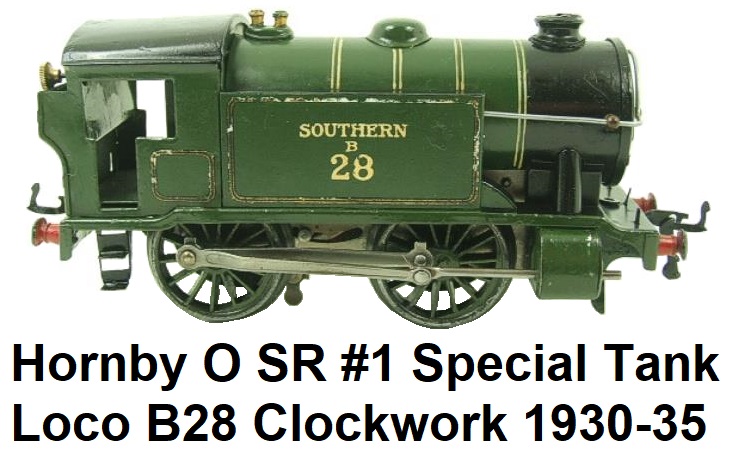
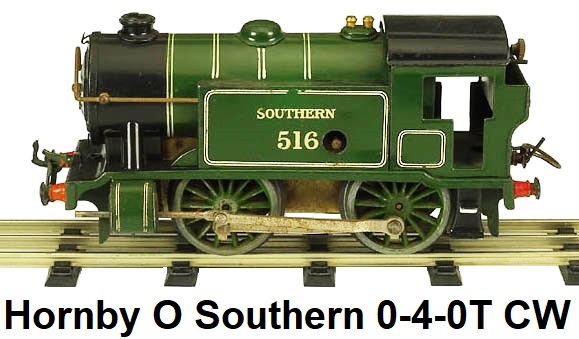 Southern Railway 'O' gauge Hornby Trains became available in 1928.
The French-type wagons now included not just the brake van and open wagons but also a wine wagon.
Improved Pullman Coaches and Composites became available, along with finely detailed lithographed sheet metal engine sheds,
and a signal gantry, together with other useful accessories. In France, the Golden Arrow train set appeared.
1929 was the year of the #2 Special Locomotives, a true-to-type range portraying real 4-4-0 locos such as the LMS
Compound, LNER Yorkshire, GWR County of Bedford, and SR #759 L1 class. All were excellent value for money. The #1 Special tender and tank
locos also graced the catalogues. This was the year that the electric trains were converted to 6 volt motors from 4 volt.
After 1929, the M-3 was discontinued, and was replaced by the 'M' locomotives, then by the 'MO' types, and still later with the
fine, long-running 'M-1' locomotives in either red or green livery.
1930 witnessed production of an export version of the #3 Nord Train painted in CPR shiny black with gold lining livery for the Canadian market. A small
cowcatcher, made of a suitable piece of Meccano, was bolted to the buffer beam and
the buffers were removed. These sets included
two 8-wheel European-styled 1st class passenger coaches that were painted in Hornby Mitropa maroon, but with the word Mitropa deleted, and Canadian Pacific Railway
appearing in gold substituted on the letterboards on each side of the cars, and with unique black-painted roofs. The locomotive was electric
powered and ran on a 15 volt current, which was unique in that regular Hornby production utilized 20 volt motors. The locomotive was fitted
with a reverse unit that was controlled by a lever located in the engine cab. Very few of these sets were produced and they are quite rare today. Less than
a dozen of these sets have ever been located.
Southern Railway 'O' gauge Hornby Trains became available in 1928.
The French-type wagons now included not just the brake van and open wagons but also a wine wagon.
Improved Pullman Coaches and Composites became available, along with finely detailed lithographed sheet metal engine sheds,
and a signal gantry, together with other useful accessories. In France, the Golden Arrow train set appeared.
1929 was the year of the #2 Special Locomotives, a true-to-type range portraying real 4-4-0 locos such as the LMS
Compound, LNER Yorkshire, GWR County of Bedford, and SR #759 L1 class. All were excellent value for money. The #1 Special tender and tank
locos also graced the catalogues. This was the year that the electric trains were converted to 6 volt motors from 4 volt.
After 1929, the M-3 was discontinued, and was replaced by the 'M' locomotives, then by the 'MO' types, and still later with the
fine, long-running 'M-1' locomotives in either red or green livery.
1930 witnessed production of an export version of the #3 Nord Train painted in CPR shiny black with gold lining livery for the Canadian market. A small
cowcatcher, made of a suitable piece of Meccano, was bolted to the buffer beam and
the buffers were removed. These sets included
two 8-wheel European-styled 1st class passenger coaches that were painted in Hornby Mitropa maroon, but with the word Mitropa deleted, and Canadian Pacific Railway
appearing in gold substituted on the letterboards on each side of the cars, and with unique black-painted roofs. The locomotive was electric
powered and ran on a 15 volt current, which was unique in that regular Hornby production utilized 20 volt motors. The locomotive was fitted
with a reverse unit that was controlled by a lever located in the engine cab. Very few of these sets were produced and they are quite rare today. Less than
a dozen of these sets have ever been located.
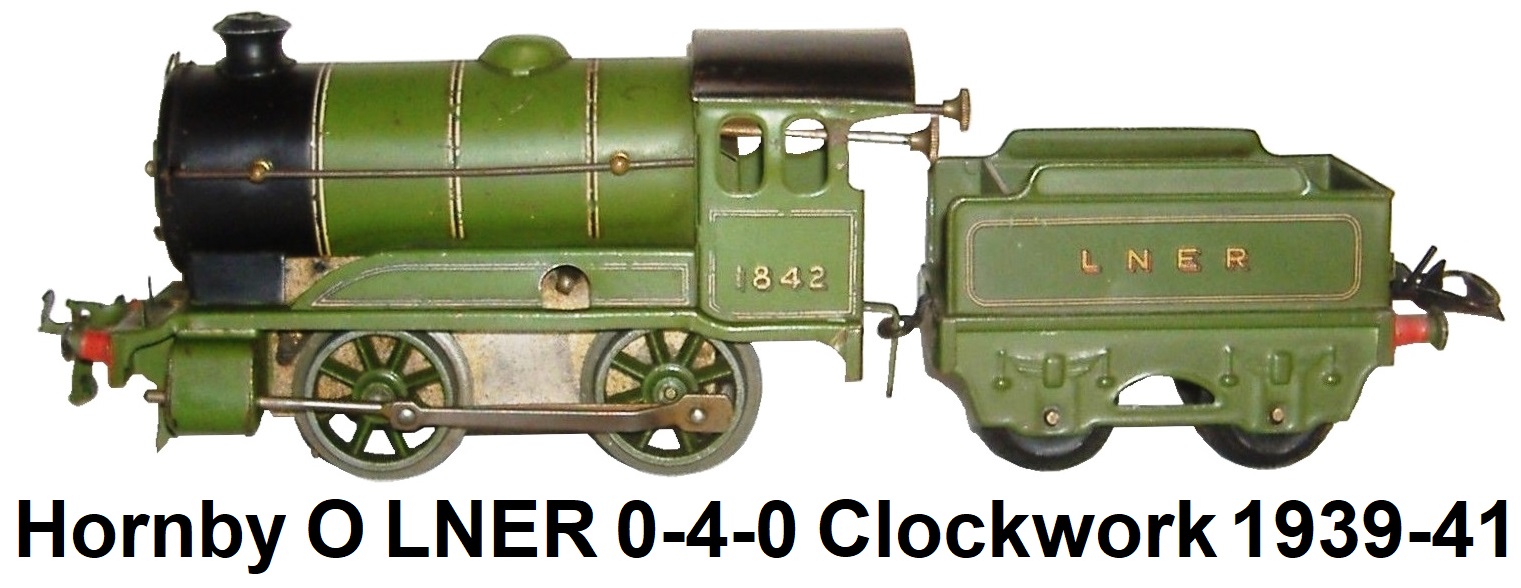 The UK market was offered US-type 'O' gauge wagons and coaches (but not locos). These 8-wheeled freight cars were produced in a wide variety,
but primarily for overseas export, as in Britain, prototype railways used the 4-wheel type goods vans and wagons. Thus, Hornby produced their
very extensive line of such model cars, in compliance with prototype practice for the home and continental markets.
The M trains were revised and rolling stock bases were revised for lower buffer
lengths. Automatic couplings were introduced in 1931. There were several new wagons also produced including Fyffes Bananas,
Open B, Fibre, Mobil Oil, Barrel, Meccano Coal, and a series of #0 Vans. The #0 and #1 tender locos were updated, as was the #1 Tank
Loco. The first of the series that became Dinky Toys - the Station Staff - were offered, as were the first electrically lit accessories.
20 volt electric trains were now being sold in France.
The UK market was offered US-type 'O' gauge wagons and coaches (but not locos). These 8-wheeled freight cars were produced in a wide variety,
but primarily for overseas export, as in Britain, prototype railways used the 4-wheel type goods vans and wagons. Thus, Hornby produced their
very extensive line of such model cars, in compliance with prototype practice for the home and continental markets.
The M trains were revised and rolling stock bases were revised for lower buffer
lengths. Automatic couplings were introduced in 1931. There were several new wagons also produced including Fyffes Bananas,
Open B, Fibre, Mobil Oil, Barrel, Meccano Coal, and a series of #0 Vans. The #0 and #1 tender locos were updated, as was the #1 Tank
Loco. The first of the series that became Dinky Toys - the Station Staff - were offered, as were the first electrically lit accessories.
20 volt electric trains were now being sold in France.
Hornby O gauge Tinplate Freight Wagons
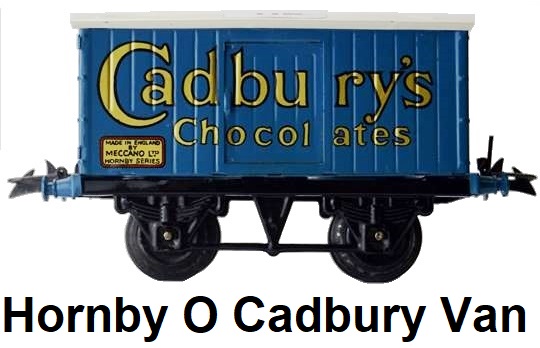
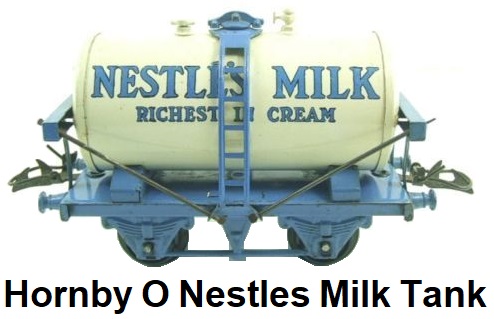
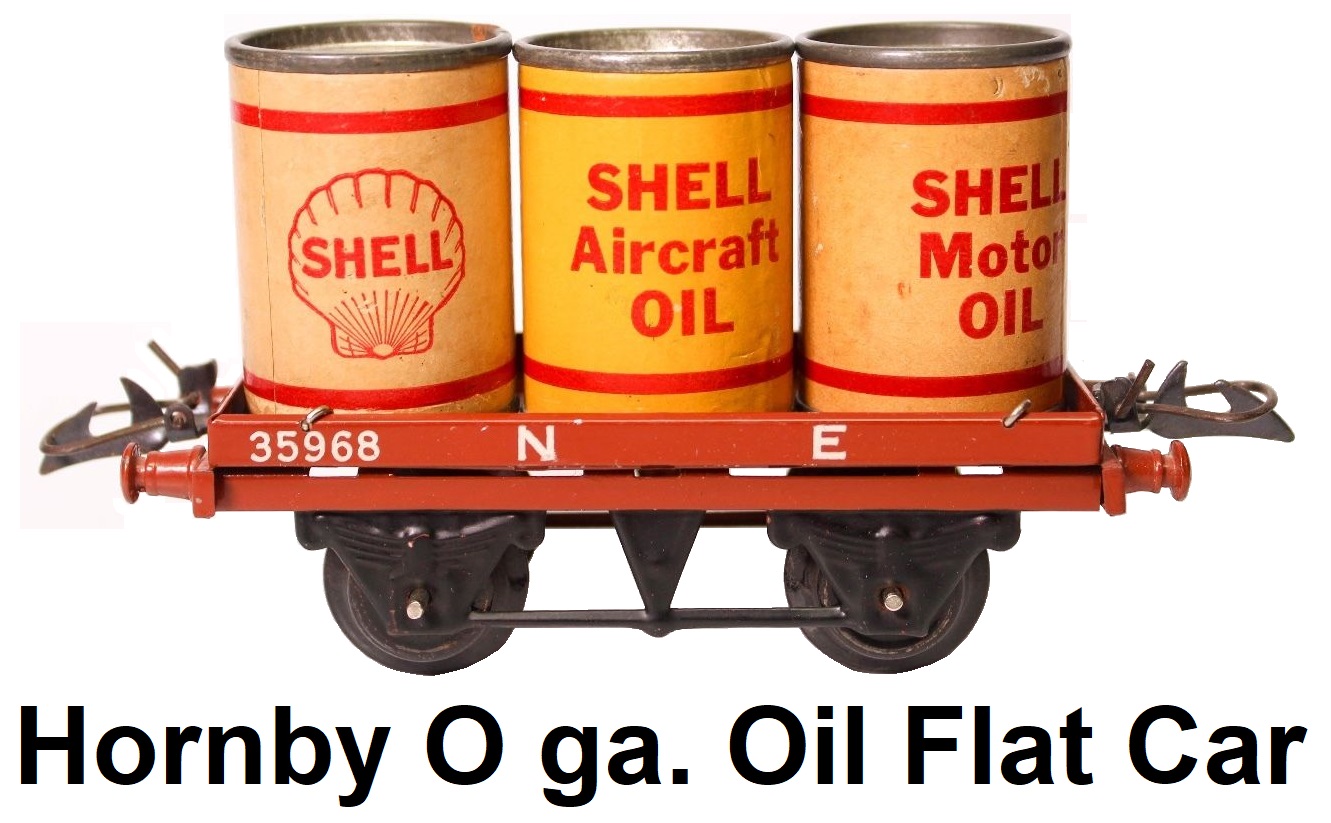
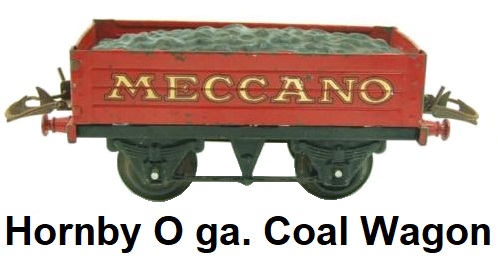
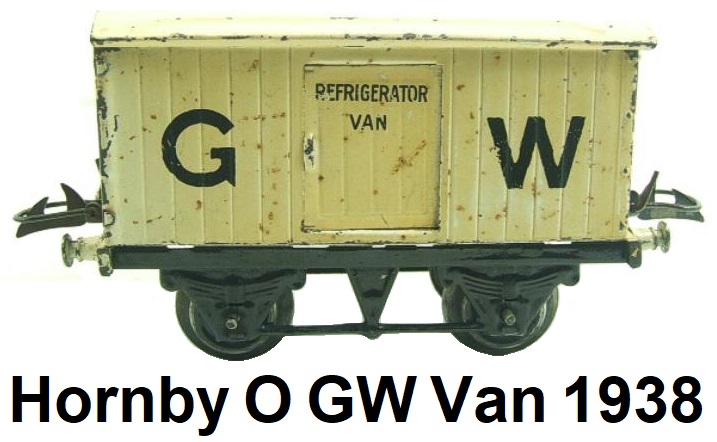
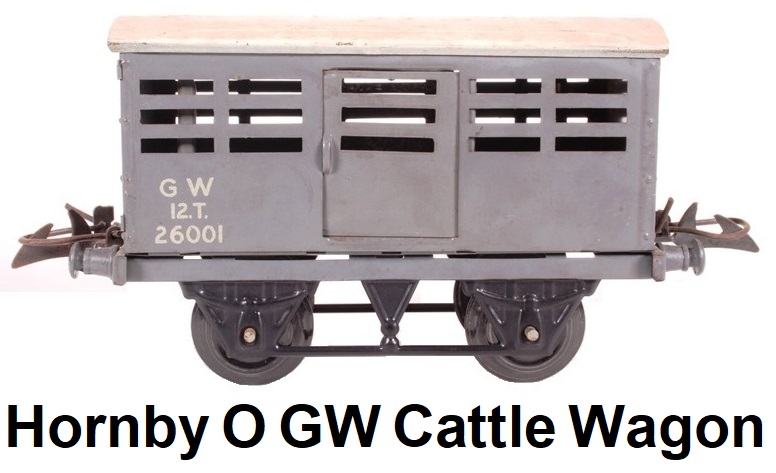
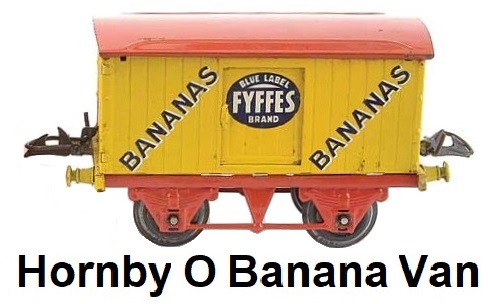
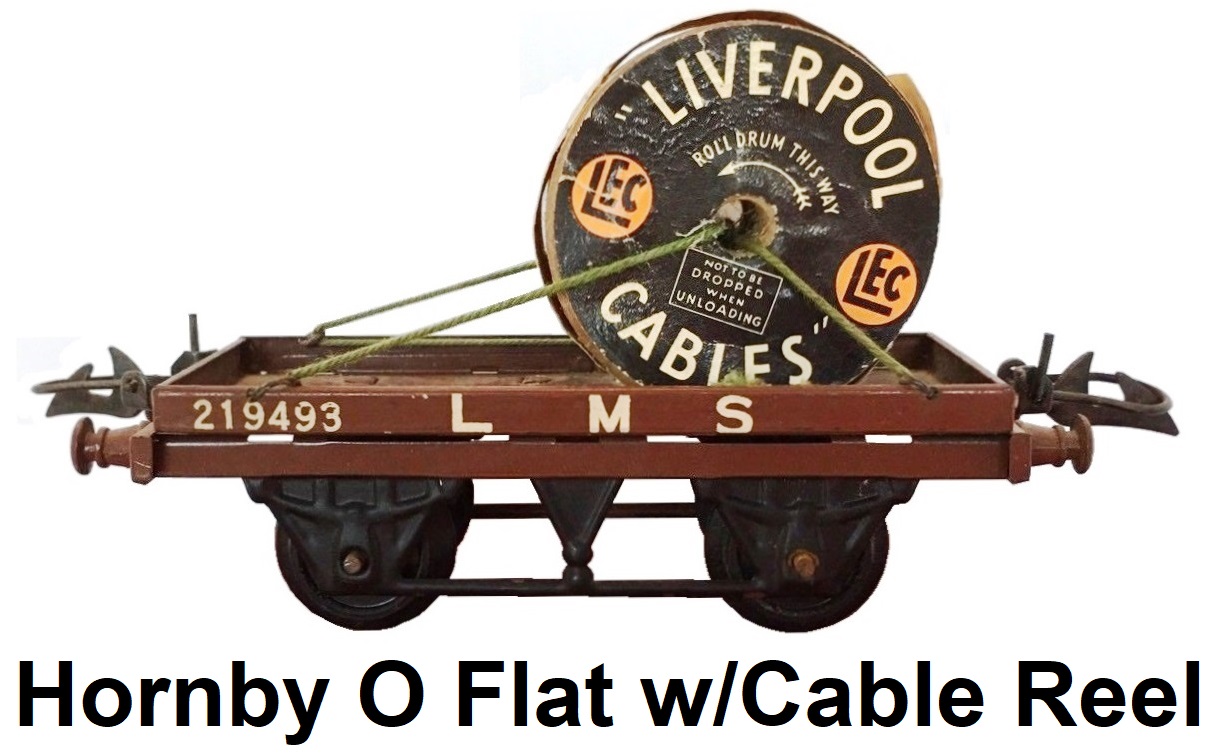
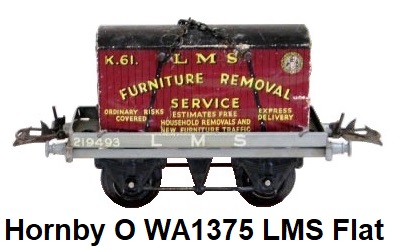
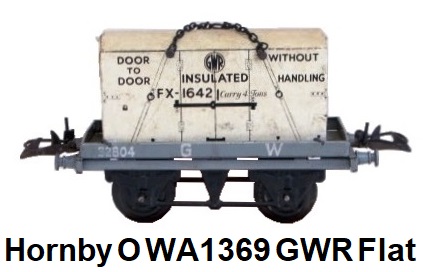
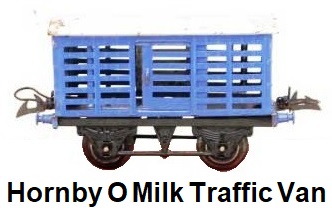
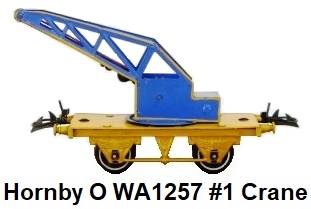
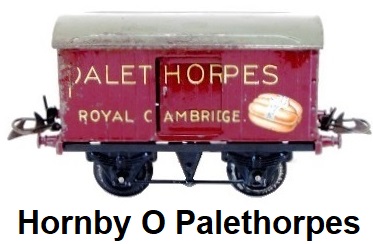
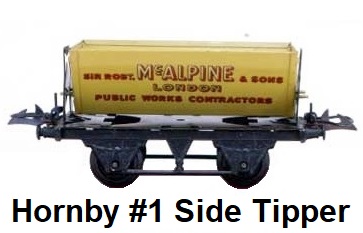
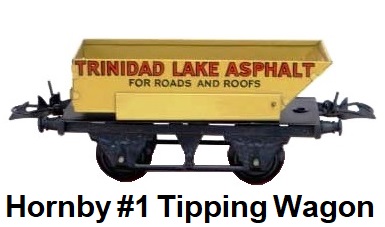
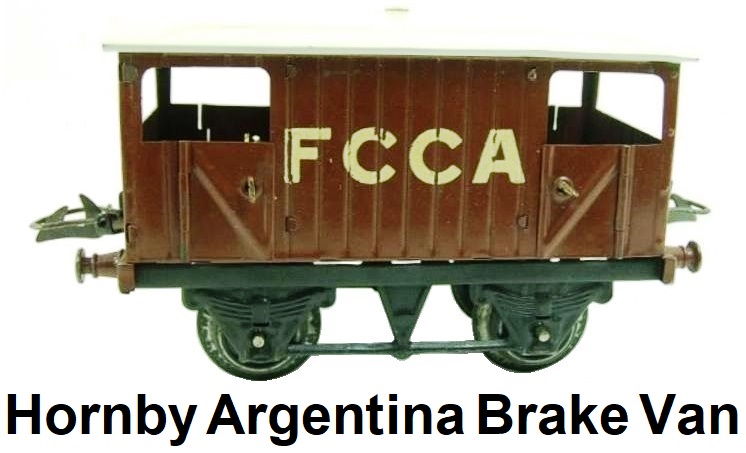
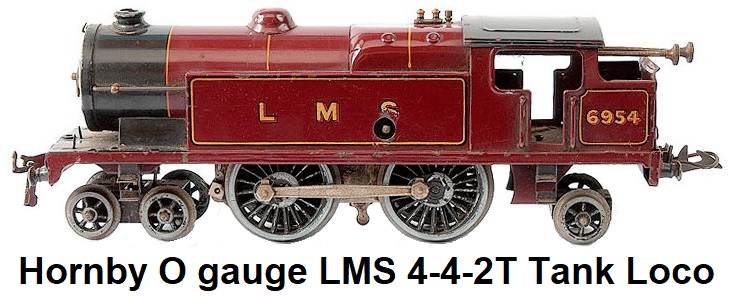 By 1932 the wide range of electrically lit accessories was completed and the UK 'O' gauge electric trains were now running on 20 volts
instead of 6. As well new models were offered, including the Swiss type and the LE2/20. A wide range of tunnels, cuttings, and countryside
sections became available, as did the Cadbury's Chocolate Private Owner Van. Paint color palettes were lightened and brightened in 1933.
A wider range of 'O' gauge 20 volt locos became available in 1934. The larger locomotives were now being equipped with an automatic reversing mechanism.
The range of accessories continued to grow, including a widening range of Dinky Toy figures, which now included the Shepherd Set.
In 1935 tinprinted bogie passenger coaches were offered and the Bramham Moor loco replaced the Yorkshire. M-type Silver Jubilee streamlined
trains were catalogued, along with high capacity wagons, and Esso, Royal Daylight and Shell-Mex and BP Wagons in 1936.
By 1932 the wide range of electrically lit accessories was completed and the UK 'O' gauge electric trains were now running on 20 volts
instead of 6. As well new models were offered, including the Swiss type and the LE2/20. A wide range of tunnels, cuttings, and countryside
sections became available, as did the Cadbury's Chocolate Private Owner Van. Paint color palettes were lightened and brightened in 1933.
A wider range of 'O' gauge 20 volt locos became available in 1934. The larger locomotives were now being equipped with an automatic reversing mechanism.
The range of accessories continued to grow, including a widening range of Dinky Toy figures, which now included the Shepherd Set.
In 1935 tinprinted bogie passenger coaches were offered and the Bramham Moor loco replaced the Yorkshire. M-type Silver Jubilee streamlined
trains were catalogued, along with high capacity wagons, and Esso, Royal Daylight and Shell-Mex and BP Wagons in 1936.
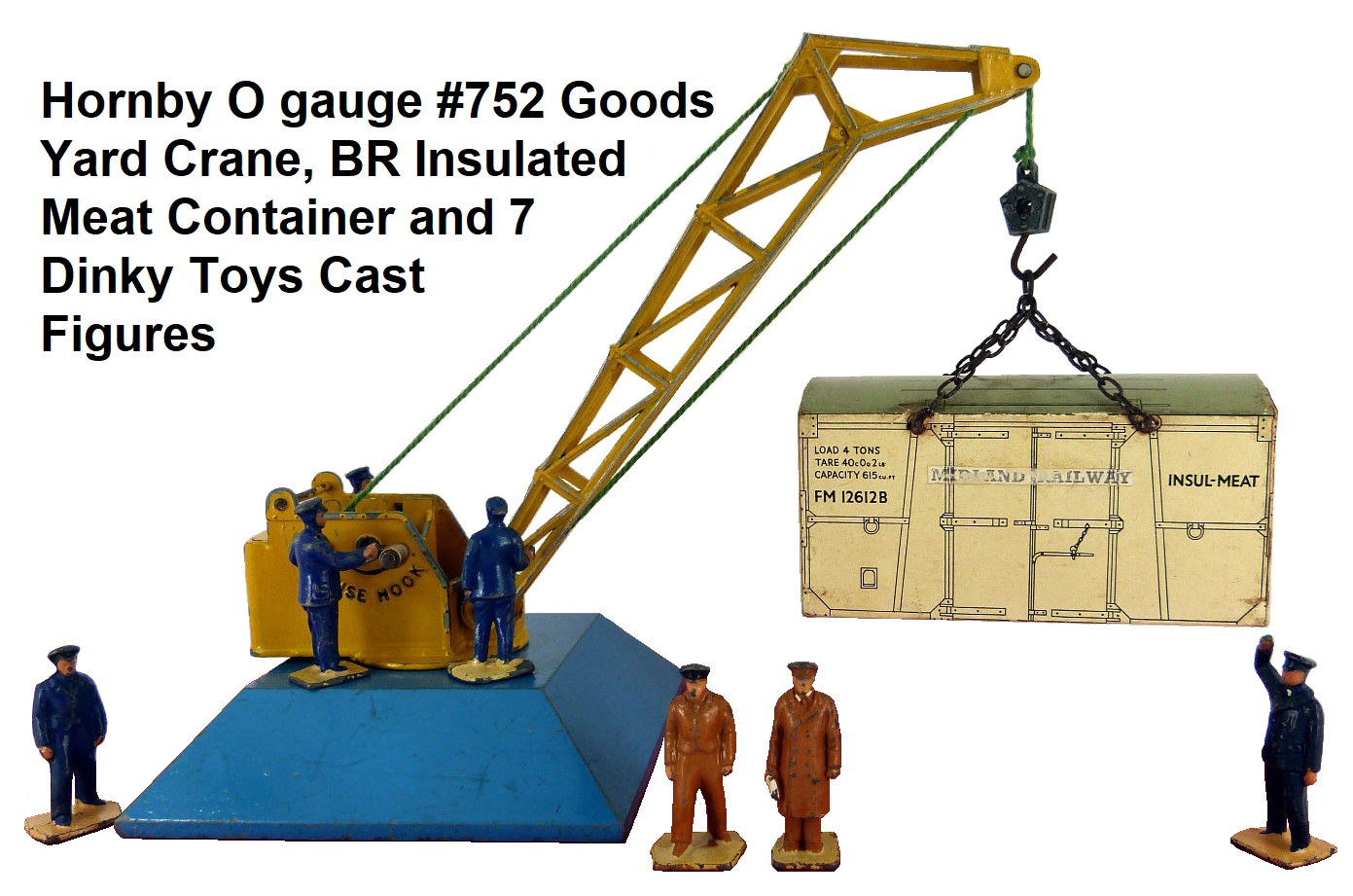
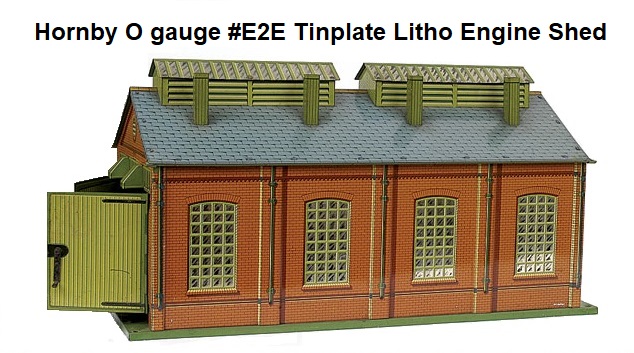
 When Frank Hornby passed away in 1936 Roland Hornby became chairman and George Jones Managing Director.
1937 was a milestone year in Hornby 'O' gauge production as the largest Hornby loco, the 4-6-2 LMS Princess Elizabeth, was introduced,
together with the #4 Eton 4-4-0 SR Schools Class and a new range of lithographed tinplate coaches. Solid steel rails were now being offered as an alternative to tinplate
track. Up until 1937, Hornby's tinplate track curve sections were chiefly in the 1' and 2'-radii, in both 2, and 3-rail. The introduction of the LMS Princess
Elizabeth was the driver for creating the special solid steel-railed track. Straight sections were 23" long, as were the curves,
in wider radius, diameter of the circle now being 6'5". Sleepers (ties) were made of pressed steel.
Few significant 'O' gauge innovations, apart from the Palethorpe's Sausage Van, the Power Ethyl Petrol Tank and a Pool Petrol tank were produced between
1938 and 1940.
When Frank Hornby passed away in 1936 Roland Hornby became chairman and George Jones Managing Director.
1937 was a milestone year in Hornby 'O' gauge production as the largest Hornby loco, the 4-6-2 LMS Princess Elizabeth, was introduced,
together with the #4 Eton 4-4-0 SR Schools Class and a new range of lithographed tinplate coaches. Solid steel rails were now being offered as an alternative to tinplate
track. Up until 1937, Hornby's tinplate track curve sections were chiefly in the 1' and 2'-radii, in both 2, and 3-rail. The introduction of the LMS Princess
Elizabeth was the driver for creating the special solid steel-railed track. Straight sections were 23" long, as were the curves,
in wider radius, diameter of the circle now being 6'5". Sleepers (ties) were made of pressed steel.
Few significant 'O' gauge innovations, apart from the Palethorpe's Sausage Van, the Power Ethyl Petrol Tank and a Pool Petrol tank were produced between
1938 and 1940.
 Hornby introduced its 'OO' gauge trains in 1938 under the name 'Hornby Dublo'. 'Dublo' was a phonetic
distortion of 'Double O' or 'OO', by which the gauge of 16.5mm became known (a scale of 4mm to the foot). This smaller gauge was well received by hobbyists,
especially those who had limited space available in their homes to build larger scale train layouts. Dublo layouts could be set up on a table top
very easily. The Hornby Dublo locomotives were made of
highly detailed die-cast metal, and the carriages and wagons were generally made of litho printed tinplate with die-cast underframes and bogies.
Buildings were built of wood. Initially just boxed sets, 5 varieties in both electric and clockwork, were available. This was a very well planned
range of electric models, successfully consolidating 12 V DC as the standard
for 'OO' gauge. Billed as 'The Perfect Table Railway', these scale models were a radical improvement on
anything previously available, both in realistic appearance and engineering. The system ran on 3 rail track,
with shoes on the locos collecting the 12 volt DC current via the center rail. Advantages of Frank Hornby's pioneering
product included simple wiring, good earthing on the two outer rails, a self-cleaning pickup and strong track which
could be reassembled without breaking. The tin base also prevented fluffing from the carpet. Hornby eventually would thrive
in the OO gauge market.
Hornby introduced its 'OO' gauge trains in 1938 under the name 'Hornby Dublo'. 'Dublo' was a phonetic
distortion of 'Double O' or 'OO', by which the gauge of 16.5mm became known (a scale of 4mm to the foot). This smaller gauge was well received by hobbyists,
especially those who had limited space available in their homes to build larger scale train layouts. Dublo layouts could be set up on a table top
very easily. The Hornby Dublo locomotives were made of
highly detailed die-cast metal, and the carriages and wagons were generally made of litho printed tinplate with die-cast underframes and bogies.
Buildings were built of wood. Initially just boxed sets, 5 varieties in both electric and clockwork, were available. This was a very well planned
range of electric models, successfully consolidating 12 V DC as the standard
for 'OO' gauge. Billed as 'The Perfect Table Railway', these scale models were a radical improvement on
anything previously available, both in realistic appearance and engineering. The system ran on 3 rail track,
with shoes on the locos collecting the 12 volt DC current via the center rail. Advantages of Frank Hornby's pioneering
product included simple wiring, good earthing on the two outer rails, a self-cleaning pickup and strong track which
could be reassembled without breaking. The tin base also prevented fluffing from the carpet. Hornby eventually would thrive
in the OO gauge market.

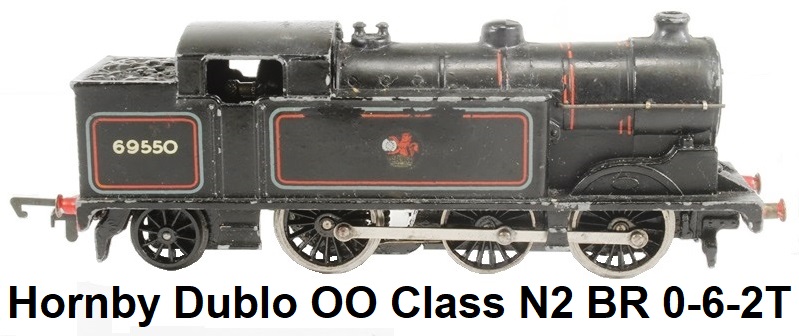

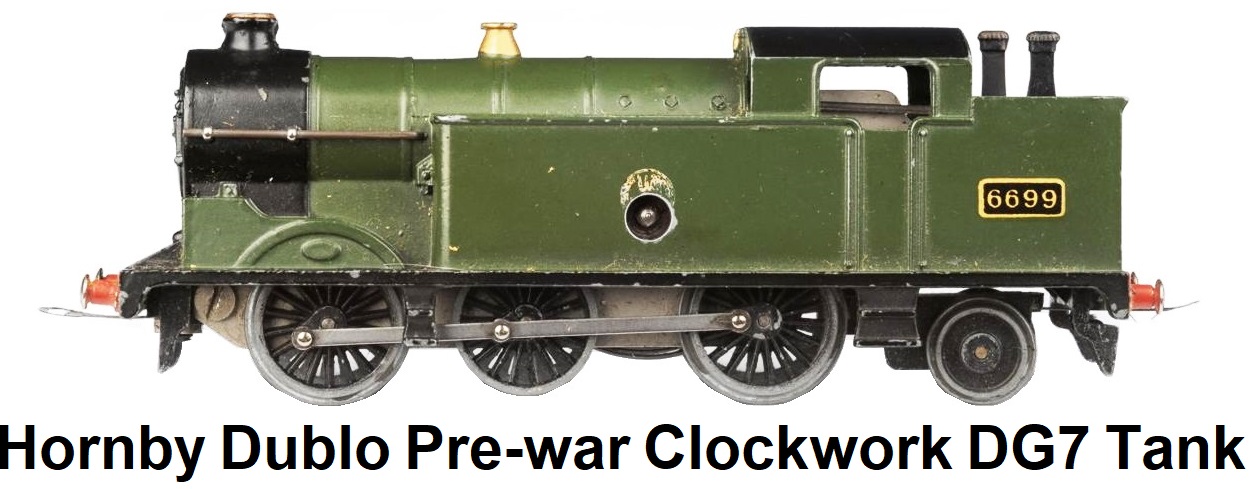 The Dublo range expanded quickly. More rolling stock and accessories were available before the Second World War. Locos
were limited to Sir Nigel Gresley, an LNER A4 Class Pacific, and an LNER Class N2 tank
locomotive in the liveries of the ‘big four’ companies of the time (GWR, LMS, LNER and SR).
Production was curtailed from 1939 to 1945 due to World War II, production being completely suspended in
1942. Production resumed after the war but without a clockwork range, and did not reach full capacity until 1948. The first sets issued were
4 tanks goods sets that were carryover from pre-war.
Immediately after the war, the government insisted on Meccano focusing on their export market to help pay off the war debt.
In the immediate post-war years, a general shortage of raw materials restricted production and new toy train items
were not introduced until the early 1950's. One new item, the Duchess of Atholl, with LMS coaches appeared in 1948, in boxes sets only. This item
had been advertised in 1939 but never produced. The A4 Sir Nigel Gresley returned, again only in boxed sets, revised to post-war appearance
without valances over the driving wheels and numbered 7 instead of 4498. In 1950 an improved, heavier, loco chassis was introduced, with powerful
new motors featuring Alnico magnets replacing the Horseshoe type, and a radio interference suppressor fitted. Eventually the Dublo range grew
to include a wide range of die-cast steam and
diesel locos, tinplate carriages and wagons, buildings
and accessories. They truly reflected the British Railways of the 1950's. Due to the phenomenal quality
and quantity produced many of these models are still available, often cheap and in working order.
The Dublo range expanded quickly. More rolling stock and accessories were available before the Second World War. Locos
were limited to Sir Nigel Gresley, an LNER A4 Class Pacific, and an LNER Class N2 tank
locomotive in the liveries of the ‘big four’ companies of the time (GWR, LMS, LNER and SR).
Production was curtailed from 1939 to 1945 due to World War II, production being completely suspended in
1942. Production resumed after the war but without a clockwork range, and did not reach full capacity until 1948. The first sets issued were
4 tanks goods sets that were carryover from pre-war.
Immediately after the war, the government insisted on Meccano focusing on their export market to help pay off the war debt.
In the immediate post-war years, a general shortage of raw materials restricted production and new toy train items
were not introduced until the early 1950's. One new item, the Duchess of Atholl, with LMS coaches appeared in 1948, in boxes sets only. This item
had been advertised in 1939 but never produced. The A4 Sir Nigel Gresley returned, again only in boxed sets, revised to post-war appearance
without valances over the driving wheels and numbered 7 instead of 4498. In 1950 an improved, heavier, loco chassis was introduced, with powerful
new motors featuring Alnico magnets replacing the Horseshoe type, and a radio interference suppressor fitted. Eventually the Dublo range grew
to include a wide range of die-cast steam and
diesel locos, tinplate carriages and wagons, buildings
and accessories. They truly reflected the British Railways of the 1950's. Due to the phenomenal quality
and quantity produced many of these models are still available, often cheap and in working order.
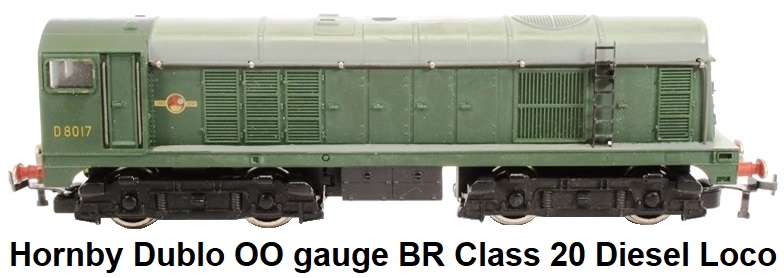


After World War Two, Hornby Dublo trains came only in electric versions. Meccano adopted Peco automatic
couplings as standard, and diecast aluminium buildings replaced the wooden models. The 1953 nationalization of the
railways resulted in Meccano easing production of the old liveried
trains and extensive use of the new British Rail liveries. In this era, Meccano made the well-loved 2-6-4 Standard Dublo tank,
Castle Class, 8F, Bo-Bo diesel, and a variety of other locomotives. The Bristol Castle, the first authentic Great Western loco, was introduced in October
1957 and the first diesel, the Class 20 Bo-Bo, came in 1958. The Bo-Bo model was a departure from the die-cast bodies of all previous Hornby Dublo locomotives as
it was made of high impact plastic. Hornby's release of the Bo-Bo diesel followed the 1958 introduction of the prototypes by British Railways.
Many of the Bo-Bo diesel locos now known as Type 20 are still in mainline service on the rail network. Plastic wheels and axles started to appear on rolling stock,
around 1957 as a prelude to introduction of a 2-rail system.
|
Hornby Dublo 'OO' gauge Coach Stock |
 |
 |
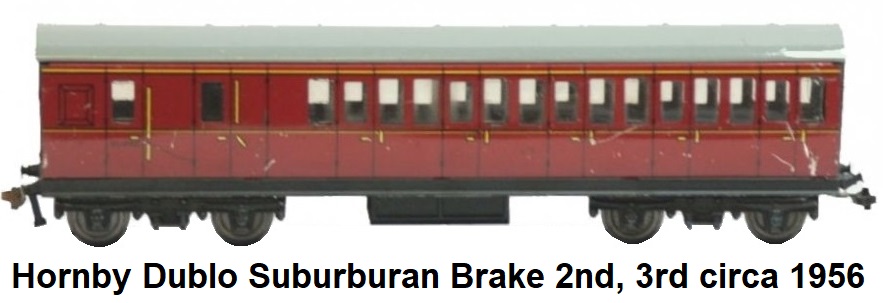 |
 |
 |
 |
 |
 |
 |
 |
 Other European toymakers also followed Hornby into OO/HO gauge railways. These included Märklin,
Fleischmann, Rivarossi, Jouef and
Lima. Whilst some of the continental makers arguably produced better models, most produced locomotives
and rolling stock representing their own country. Only a few British style locomotives were produced by the foreign makers.
Equally, continental railways were not as popular in Britain and were rarely modelled. However, the quality of the locomotives,
especially those made by the German manufacturers, makes them highly sought after by collectors. Due to competition from model
manufacturer Tri-ang, Meccano changed its manufacturing methods. Rovex Tri-ang, later Tri-ang Railways, had a 2-rail
system in OO that was of plastic construction. In 1958 the first plastic Hornby OO wagons arrived
when the company introduced a grain wagon with a plastic body. Plastic buildings first appeared in 1959. The other main Hornby rival was
Trix who also produced a three rail system. Trix had been introduced several years before Hornby Dublo but at
first they had a rather crude toy like appearance. Later on the Trix products became much more detailed and very similar to Hornby Dublo trains.
Other European toymakers also followed Hornby into OO/HO gauge railways. These included Märklin,
Fleischmann, Rivarossi, Jouef and
Lima. Whilst some of the continental makers arguably produced better models, most produced locomotives
and rolling stock representing their own country. Only a few British style locomotives were produced by the foreign makers.
Equally, continental railways were not as popular in Britain and were rarely modelled. However, the quality of the locomotives,
especially those made by the German manufacturers, makes them highly sought after by collectors. Due to competition from model
manufacturer Tri-ang, Meccano changed its manufacturing methods. Rovex Tri-ang, later Tri-ang Railways, had a 2-rail
system in OO that was of plastic construction. In 1958 the first plastic Hornby OO wagons arrived
when the company introduced a grain wagon with a plastic body. Plastic buildings first appeared in 1959. The other main Hornby rival was
Trix who also produced a three rail system. Trix had been introduced several years before Hornby Dublo but at
first they had a rather crude toy like appearance. Later on the Trix products became much more detailed and very similar to Hornby Dublo trains.
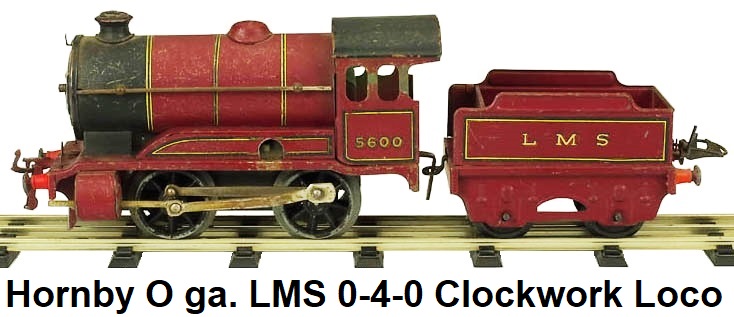 Meanwhile the company plugged on producing a range of very old-fashioned 'O' gauge models from 1945 onwards. These were
mainly of M0, M1 and the 101 trains. The 4-6-2 Princess Elizabeth was not produced after WW-II, nor was the #900 Southern Railways
Schools Class Eton. These two lcomotives were considered the best Hornby 'O' gauge locomotives ever made. Between the years 1948-50 the Type 501
trains became available and export electric versions were produced for 2 years in limited numbers. Now nearly all the trains produced in 'O'
gauge were clockwork, with only a very few electric trains made, all for export. GW and SR trains were produced at this time, but LMS
and LNER soon became the only normal liveries. Some bogie stock was produced, again in limited quantities, and some exclusively for export.
One unique export item produced during this era was the only other 'O' gauge set produced exclusively for the Canadian market. This was an enamel finished
version of the Silver Link streamlined set. The locomotive had no number, and the tender was lettered CPR. They were both painted in green.
The set included two 4-wheel tin coaches in maroon with gold striping. These passenger sets are also quite rare today. From 1951-53 shortages of
materials continued to hold back production, but soon levels rose to bring the fortunes of the factory to their highest point.
However, the post-war 'O' gauge range was to continue as a shadow of its pre-war glories. BR liveries were introduced in the
1954-56 time frame. Finally in 1957 Hornby completely retooled much of the 'O' gauge range instead of taking the opportunity
to discontinue it, indicative of major failings at management level. They stopped making most of the finer pieces, simplified some of the
remaining accessories, and reverted to only making the simpler 0-4-0 locos. This revamped, simpler range removed the pre-war numbering
system with its various tiered numbers and 'M' variants, and shrank to four basic levels of train set, numbered 20, 30, 40 and 50 for the
goods sets, and 21, 31, 41 and 51 for the corresponding passenger sets, all now only available in clockwork.
Meanwhile the company plugged on producing a range of very old-fashioned 'O' gauge models from 1945 onwards. These were
mainly of M0, M1 and the 101 trains. The 4-6-2 Princess Elizabeth was not produced after WW-II, nor was the #900 Southern Railways
Schools Class Eton. These two lcomotives were considered the best Hornby 'O' gauge locomotives ever made. Between the years 1948-50 the Type 501
trains became available and export electric versions were produced for 2 years in limited numbers. Now nearly all the trains produced in 'O'
gauge were clockwork, with only a very few electric trains made, all for export. GW and SR trains were produced at this time, but LMS
and LNER soon became the only normal liveries. Some bogie stock was produced, again in limited quantities, and some exclusively for export.
One unique export item produced during this era was the only other 'O' gauge set produced exclusively for the Canadian market. This was an enamel finished
version of the Silver Link streamlined set. The locomotive had no number, and the tender was lettered CPR. They were both painted in green.
The set included two 4-wheel tin coaches in maroon with gold striping. These passenger sets are also quite rare today. From 1951-53 shortages of
materials continued to hold back production, but soon levels rose to bring the fortunes of the factory to their highest point.
However, the post-war 'O' gauge range was to continue as a shadow of its pre-war glories. BR liveries were introduced in the
1954-56 time frame. Finally in 1957 Hornby completely retooled much of the 'O' gauge range instead of taking the opportunity
to discontinue it, indicative of major failings at management level. They stopped making most of the finer pieces, simplified some of the
remaining accessories, and reverted to only making the simpler 0-4-0 locos. This revamped, simpler range removed the pre-war numbering
system with its various tiered numbers and 'M' variants, and shrank to four basic levels of train set, numbered 20, 30, 40 and 50 for the
goods sets, and 21, 31, 41 and 51 for the corresponding passenger sets, all now only available in clockwork.






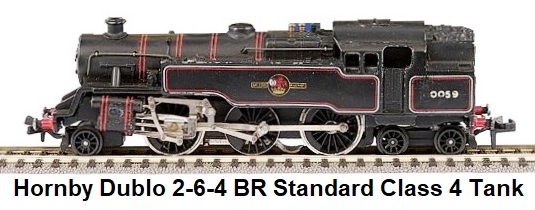
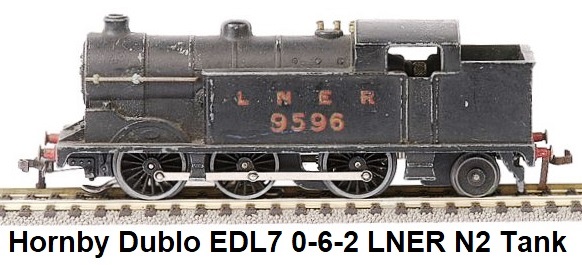
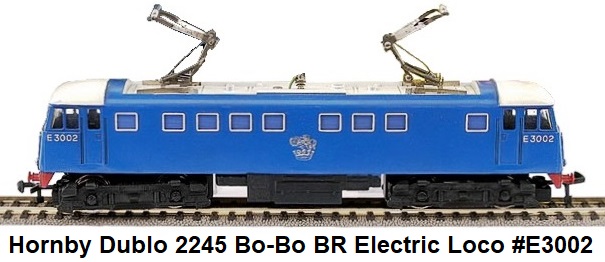
Like its counterparts Bassett-Lowke and Exley
in the UK and Lionel and American Flyer in the US, Hornby had thrived
in the first half of the decade but struggled in the late 1950's. The company was slow to recognize
the threat posed by rival manufacturers (particularly Tri-ang/Rovex) and to realize the potential of plastic. It wasn't
until 1958 when Hornby finally issued OO gauge plastic rolling stock in the super-detail.
In 1959, far too late, Hornby introduced a two-rail OO/HO track system, which used a mixture of plastic and tinplate,
but even then the system was complicated and difficult to use in comparison to its rivals. When Meccano announced the
introduction of the new 2-rail system they stated that production of the 3-rail system would carry on as long as
there was a demand, and 3-rail component production lasted until 1964. The huge investment involved in changing over to a badly
conceived 2-rail system was partly responsible for the eventual collapse of the Meccano Company.
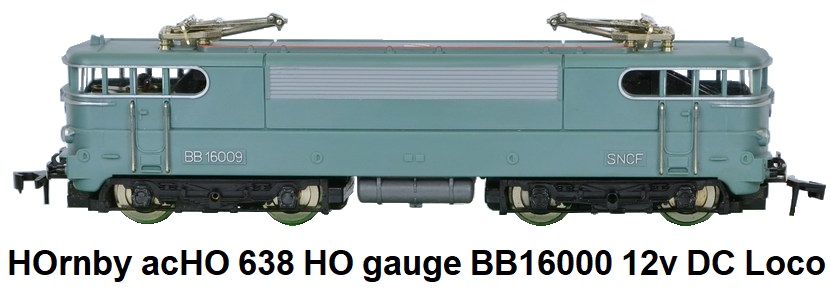 During the years 1960 to 1973 the French subsidiary of Meccano, Ltd. produced HOrnby acHO railroad models in HO scale.
Initially production was located at Bobigny upon Seine near Paris, later at Calais. Hornby had bought the bankrupt French firm SMCF.
The trains were models of French prototypes, the only exception being the Rheingold RAm of the Deutsche Bundesbahn. The first models
During the years 1960 to 1973 the French subsidiary of Meccano, Ltd. produced HOrnby acHO railroad models in HO scale.
Initially production was located at Bobigny upon Seine near Paris, later at Calais. Hornby had bought the bankrupt French firm SMCF.
The trains were models of French prototypes, the only exception being the Rheingold RAm of the Deutsche Bundesbahn. The first models
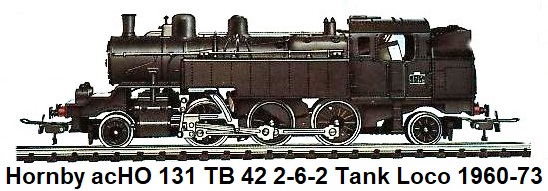 produced were sets that featured a BB 16000 with 2 cars, a 131 TRB steam loco, an
0-6-0 DB diesel loco and a set of East Suburban cars. The French Hornby operations had no connection with Rovex/Tri-ang who eventually
bought up the Hornby trade name when Meccano closed in 1964. French Meccano as well as Argentinian Meccano continued to produce toys
for a few more years as independent companies. Meccano France was eventually acquired by the American group General Mills. The last catalog issued dates from 1973,
and production ceased at the beginning of 1974.
produced were sets that featured a BB 16000 with 2 cars, a 131 TRB steam loco, an
0-6-0 DB diesel loco and a set of East Suburban cars. The French Hornby operations had no connection with Rovex/Tri-ang who eventually
bought up the Hornby trade name when Meccano closed in 1964. French Meccano as well as Argentinian Meccano continued to produce toys
for a few more years as independent companies. Meccano France was eventually acquired by the American group General Mills. The last catalog issued dates from 1973,
and production ceased at the beginning of 1974.
Hornby 'O' gauge trains were first offered in 1920 and last produced in 1962, although stocks remained
throughout the 1960's.
Most Hornby 'O' gauge collectors concentrate on prewar items and seek items such as
the Princess Elizabeth (Hornby's only 6 coupled locomotive), the #2 Special 4-4-0's or the beautiful
lithographed bogie corridor coaches. Hornby's postwar offerings were headed by 0-4-0 tender and tank locomotives.
Remaining stocks of 'O' gauge were either scrapped or sold to the local retailer Hattons. In OO, the Super
Detail coaches appeared in 1960 along with plastic couplings. A new Ringfield motor was announced.
When two beginners' sets launched in 1963 failed to sell, Meccano halted production of the Dublo line in 1964. That year also marked
the end of 3-rail production. And the last official Hornby Dublo model, the AL1 electric, was released.
 In 1964, Lines Bros Ltd., the parent company of rival
Tri-ang Railways purchased Meccano Ltd., and merged
Hornby and Tri-ang into Tri-ang Hornby. The acquisition included Dinky Toys. Tri-ang initially continued production of the acquired
Hornby-Dublo range, under the Tri-ang Hornby name, but eventually the former Hornby line was discontinued in favor of Tri-ang's less costly plastic designs.
Only two Hornby products were fully integrated into the Tri-ang Hornby line. These were the E3000 locomotive and the Terminus
and Through Station Kit. Tri-ang Hornby became known for the British blue color used on the liveries of its diesel locomotives. During this period, several
locomotives, including the Coronation Class and Flying Scotsman, were introduced.
The Hornby Dublo tooling was sold to G & R Wrenn a Lines Bros. Group subsidiary,
which continued to make most of the loco range and
'superdetail' rolling stock. The trading name of Tri-ang Hornby continued even though there was no trace of
the original Hornby Dublo left.
In 1964, Lines Bros Ltd., the parent company of rival
Tri-ang Railways purchased Meccano Ltd., and merged
Hornby and Tri-ang into Tri-ang Hornby. The acquisition included Dinky Toys. Tri-ang initially continued production of the acquired
Hornby-Dublo range, under the Tri-ang Hornby name, but eventually the former Hornby line was discontinued in favor of Tri-ang's less costly plastic designs.
Only two Hornby products were fully integrated into the Tri-ang Hornby line. These were the E3000 locomotive and the Terminus
and Through Station Kit. Tri-ang Hornby became known for the British blue color used on the liveries of its diesel locomotives. During this period, several
locomotives, including the Coronation Class and Flying Scotsman, were introduced.
The Hornby Dublo tooling was sold to G & R Wrenn a Lines Bros. Group subsidiary,
which continued to make most of the loco range and
'superdetail' rolling stock. The trading name of Tri-ang Hornby continued even though there was no trace of
the original Hornby Dublo left.
 Tri-ang model railways had its beginning in a small firm called Rovex Plastics set up in 1947.
This firm was making plastic model cars, but after conflict with Rover Cars over the use of the name Rovex,
the company moved into the model railway field, making train sets for the department store chain Marks
and Spencers. The first Rovex train set was in the Marks & Spencers stores for Christmas 1950, but in
October 1951 the company was taken over by Lines Bros. Ltd, who manufactured Tri-ang baby prams
and bicycles, and were looking to break into the model train market. With the resources of the Lines
Bros. group, great expansion was possible, and by 1953 the outline of the Tri-ang range was available
in the shops.
Tri-ang model railways had its beginning in a small firm called Rovex Plastics set up in 1947.
This firm was making plastic model cars, but after conflict with Rover Cars over the use of the name Rovex,
the company moved into the model railway field, making train sets for the department store chain Marks
and Spencers. The first Rovex train set was in the Marks & Spencers stores for Christmas 1950, but in
October 1951 the company was taken over by Lines Bros. Ltd, who manufactured Tri-ang baby prams
and bicycles, and were looking to break into the model train market. With the resources of the Lines
Bros. group, great expansion was possible, and by 1953 the outline of the Tri-ang range was available
in the shops.
 These model trains represented a great step forward in the production of model trains.
The use of
plastic injection molding meant: low cost, cheap mass production, less weight (less powerful motors required),
greater detail could be reproduced. The Tri-ang range continued to grow throughout the fifties and early sixties.
By 1964 Tri-ang dominated the model train markets in the United Kingdom, and colonial countries such as
Australia, New Zealand, South Africa and Canada. During the late 1950’s and early 1960’s there was a large
production of Tri-ang products in Australia and New Zealand. This was to overcome trade barriers in place
because of massive trading deficits. There was a small production in South Africa. Models designed for the
Canadian and American markets were made in England.
These model trains represented a great step forward in the production of model trains.
The use of
plastic injection molding meant: low cost, cheap mass production, less weight (less powerful motors required),
greater detail could be reproduced. The Tri-ang range continued to grow throughout the fifties and early sixties.
By 1964 Tri-ang dominated the model train markets in the United Kingdom, and colonial countries such as
Australia, New Zealand, South Africa and Canada. During the late 1950’s and early 1960’s there was a large
production of Tri-ang products in Australia and New Zealand. This was to overcome trade barriers in place
because of massive trading deficits. There was a small production in South Africa. Models designed for the
Canadian and American markets were made in England.
The Tri-ang Hornby period is best remembered by many for the change to British Rail
blue liveries on diesel locomotives, the introduction of pre-Nationalization
liveries for steam locomotives and the launch of Battle Space and Battle Zone. Some of the
locomotives produced during this time included the E3000, Hymek, Class 37, M7, Hall Class,
Coronation Class, Flying Scotsman and Evening Star. In 1967 Hornby was merged internally into Rovex
Industries, which by 1969 was Rovex Tri-ang Ltd.
 The Tri-ang group was disbanded in 1971 when Meccano Ltd's owner Lines Bros. filed for bankruptcy.
When the Lines Group of companies was split up and sold, the Tri-ang name went with the manufacture of
prams (Tri-ang Pedigree). Airfix bought Meccano. The former Tri-ang Hornby train line was sold to Dunbee-Combex-Marx, becoming Hornby Railways
(they could not use the Tri-ang name) in 1972.
Even though the name changed, production continued at the Margate factory. The specification of a large
part of the range was also upgraded to make it more attractive to adult enthusiasts and improvements
were carried out to provide finer scale wheels, wire handrails on locomotives, better paint finish
on plastic bodies and high definition printing of logos.
The Tri-ang group was disbanded in 1971 when Meccano Ltd's owner Lines Bros. filed for bankruptcy.
When the Lines Group of companies was split up and sold, the Tri-ang name went with the manufacture of
prams (Tri-ang Pedigree). Airfix bought Meccano. The former Tri-ang Hornby train line was sold to Dunbee-Combex-Marx, becoming Hornby Railways
(they could not use the Tri-ang name) in 1972.
Even though the name changed, production continued at the Margate factory. The specification of a large
part of the range was also upgraded to make it more attractive to adult enthusiasts and improvements
were carried out to provide finer scale wheels, wire handrails on locomotives, better paint finish
on plastic bodies and high definition printing of logos.
 By 1976 Hornby was facing challenges from Palitoy and Airfix, both of which were producing high
quality detailed models.
Detail on the models was upgraded to make the product line more attractive to adult hobbyists. A multiple
train control system named Zero 1 was introduced in the early 1980's. This digital system was a forerunner
to the Digital Command Control (DCC) system, an NMRA open standard, which appeared in the 1990's.
By 1976 Hornby was facing challenges from Palitoy and Airfix, both of which were producing high
quality detailed models.
Detail on the models was upgraded to make the product line more attractive to adult hobbyists. A multiple
train control system named Zero 1 was introduced in the early 1980's. This digital system was a forerunner
to the Digital Command Control (DCC) system, an NMRA open standard, which appeared in the 1990's.
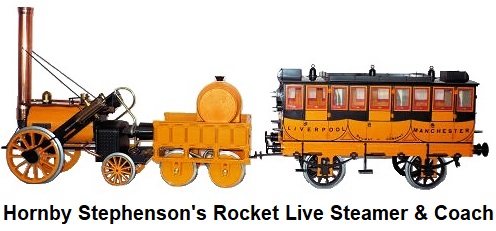 As part of the 1980 Rocket 150 year celebrations, Hornby released a live-steam-powered 3½" gauge locomotive
model of the Stephenson's Rocket. A major goal was to make real live-steam accessible to an indoor domestic environment.
The boiler was considerably smaller than the external diameter, surrounded by a thick insulating jacket to prevent burns.
It was fueled by butane gas, from cigarette lighter refills. To provide more torque from the small cylinders, gearing was
adeptly hidden between the cranks and the wheels. The track was of asymmetric molded plastic units, representing the
fish-belly rails of the period. These could be assembled either way round, to give either curved or straight track. By 1980
the market was extremely tough and Dunbee-Combex-Marx was liquidated, placing Rovex in receivership.
As part of the 1980 Rocket 150 year celebrations, Hornby released a live-steam-powered 3½" gauge locomotive
model of the Stephenson's Rocket. A major goal was to make real live-steam accessible to an indoor domestic environment.
The boiler was considerably smaller than the external diameter, surrounded by a thick insulating jacket to prevent burns.
It was fueled by butane gas, from cigarette lighter refills. To provide more torque from the small cylinders, gearing was
adeptly hidden between the cranks and the wheels. The track was of asymmetric molded plastic units, representing the
fish-belly rails of the period. These could be assembled either way round, to give either curved or straight track. By 1980
the market was extremely tough and Dunbee-Combex-Marx was liquidated, placing Rovex in receivership.
In 1980 Hornby became Hornby Hobbies and in 1981 a management buyout saw the company back
on a sound footing. It went public in 1986. Changes taking place on British Railways and privatization of
the railways at this time brought several new eye catching liveries that were eagerly modelled by Hornby.
The demand for these liveries and higher standards of modelling led to a number of models being retooled.
New products also included a Thomas the Tank Engine and Friends range, based on the television series.
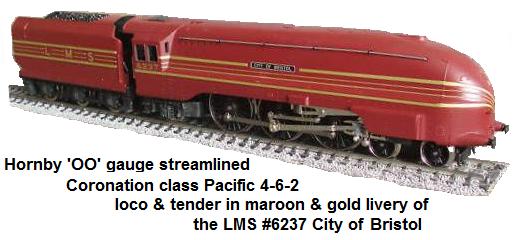 By the early 1990's Hornby again faced competition from newcomers like Dapol
and established foreign manufacturers, including Lima
and Bachmann Industries.
Manufacturing was moved to Guangdong province in China in 1995, completed by 1999, cutting costs and
improving quality, according to the company. The first totally new ‘Far East’ model was a Rebuilt Merchant
Navy Class locomotive, which was to become a benchmark of quality for future locomotives and rolling stock.
As part of the process Hornby also brought in some of Dapol's
products and also some of the old Airfix molds (by then owned by Dapol). Train sets associated with The
Railway Children (that was released in time for Christmas orders when the film came out), Thomas the Tank
Engine and Friends and Harry Potter (the "Hogwarts Express") have been particularly profitable ventures.
In September 2003 Hornby released its first steam-powered 'OO' gauge locomotive, a model of the
record-breaking Mallard. Several other "Live Steam" locomotives have now been produced.
By the early 1990's Hornby again faced competition from newcomers like Dapol
and established foreign manufacturers, including Lima
and Bachmann Industries.
Manufacturing was moved to Guangdong province in China in 1995, completed by 1999, cutting costs and
improving quality, according to the company. The first totally new ‘Far East’ model was a Rebuilt Merchant
Navy Class locomotive, which was to become a benchmark of quality for future locomotives and rolling stock.
As part of the process Hornby also brought in some of Dapol's
products and also some of the old Airfix molds (by then owned by Dapol). Train sets associated with The
Railway Children (that was released in time for Christmas orders when the film came out), Thomas the Tank
Engine and Friends and Harry Potter (the "Hogwarts Express") have been particularly profitable ventures.
In September 2003 Hornby released its first steam-powered 'OO' gauge locomotive, a model of the
record-breaking Mallard. Several other "Live Steam" locomotives have now been produced.
 Since then Hornby has bought Lima, an Italian model railway equipment manufacturer
that had previously acquired Jouef, a French manufacturer. Some of the ex-Lima
models appear in the main Hornby products list. This range is known as Hornby International. This
acquisition also included the Rivarossi line of
HO-scale products, also originally from Italy, and the Arnold brand of N-scale
products. They also took over the Spanish model railway company Electrotren. Electrotren had been the Spanish
importer for Scalextric, sold in Spain as Superslot. The takeover was at the request of the Spanish company and
was not due to obvious financial problems. Electrotren remained independent outside of the Hornby International
umbrella.
Since then Hornby has bought Lima, an Italian model railway equipment manufacturer
that had previously acquired Jouef, a French manufacturer. Some of the ex-Lima
models appear in the main Hornby products list. This range is known as Hornby International. This
acquisition also included the Rivarossi line of
HO-scale products, also originally from Italy, and the Arnold brand of N-scale
products. They also took over the Spanish model railway company Electrotren. Electrotren had been the Spanish
importer for Scalextric, sold in Spain as Superslot. The takeover was at the request of the Spanish company and
was not due to obvious financial problems. Electrotren remained independent outside of the Hornby International
umbrella.
 The BR 4-4-0 Class 2P steam outline loco model was a brand new OO gauge example developed in 2006 as part
of Hornby Model Railways Super Detail series. It was a tender driven model. That year also saw the release of a live
steam driven model of the Class A3 Flying Scotsman with double tender. A linmited run of 1,000 models were offered.
In November 2006, Hornby Hobbies acquired Airfix and Humbrol paints for the
sum of £2.6 million. The parent company had gone into administration earlier that year after
cash flow problems. With the competition continuing mainly from Bachmann Industries, and to a much lesser extent from
the minor and generally niche players such as the Danish model railway company Heljan, Dapol, Vi Trains and Peco, in 2008
Hornby Railways began to produce a large range of highly detailed British steam and diesel locomotives, such as the BR 9F,
LNER Class A4, SR Merchant Navy, Class 60, Class 50, Class 31 and Class 08.
The BR 4-4-0 Class 2P steam outline loco model was a brand new OO gauge example developed in 2006 as part
of Hornby Model Railways Super Detail series. It was a tender driven model. That year also saw the release of a live
steam driven model of the Class A3 Flying Scotsman with double tender. A linmited run of 1,000 models were offered.
In November 2006, Hornby Hobbies acquired Airfix and Humbrol paints for the
sum of £2.6 million. The parent company had gone into administration earlier that year after
cash flow problems. With the competition continuing mainly from Bachmann Industries, and to a much lesser extent from
the minor and generally niche players such as the Danish model railway company Heljan, Dapol, Vi Trains and Peco, in 2008
Hornby Railways began to produce a large range of highly detailed British steam and diesel locomotives, such as the BR 9F,
LNER Class A4, SR Merchant Navy, Class 60, Class 50, Class 31 and Class 08.
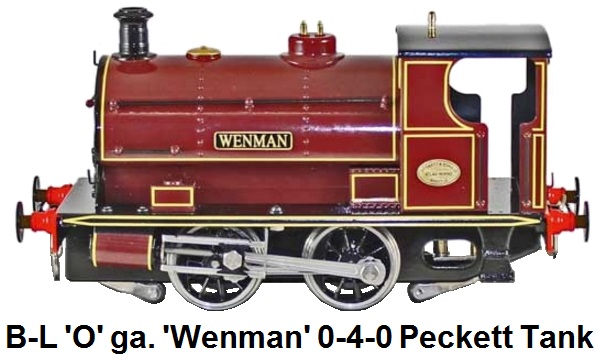
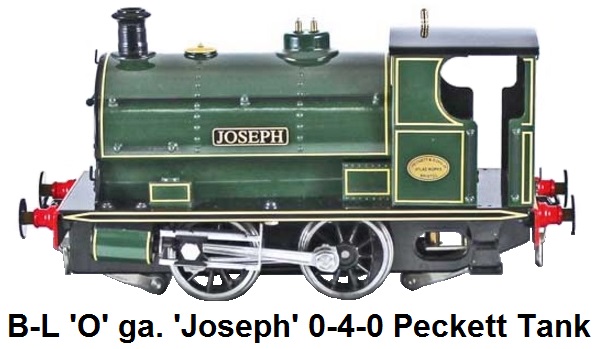
 In May of 2008, Hornby announced the acquisition of Corgi Classics Limited, one of the world's oldest makers
of collectable die-cast models of trucks, buses, cars and aeroplanes, from Corgi International Limited for £7.5million.
Hornby acquired Bassett-Lowke when it purchased Corgi in 2008. A few new Bassett-Lowke models
appeared in the Hornby catalogs starting in 2009, but these were remaining Corgi stock. Offerings included a small Peckett
In May of 2008, Hornby announced the acquisition of Corgi Classics Limited, one of the world's oldest makers
of collectable die-cast models of trucks, buses, cars and aeroplanes, from Corgi International Limited for £7.5million.
Hornby acquired Bassett-Lowke when it purchased Corgi in 2008. A few new Bassett-Lowke models
appeared in the Hornby catalogs starting in 2009, but these were remaining Corgi stock. Offerings included a small Peckett
 0-4-0T industrial steam tank loco produced in two versions, one named “Wenman” and one named “Joseph” in honor of Wenman J.
Bassett-Lowke. Also produced of heavy sheet-metal construction were 2 Bassett-Lowke 'O' gauge steam outline locomotives in
limited runs. They were a class J39 0-6-0 with a 6-wheel tender in a British Railways paint scheme, and a Patriot Class 4-6-0
in British Rail green named “E. Tootal Broadhurst”. The very small production runs were 130 and 180 units respectively.
Beginning in 2009, the Hornby Shop and Visitor Centre was in development. Christmas 2009 saw the launch of the new Hornby
Shop at Margate in Kent, with the visitor centre still in production. July 2010 saw the opening of the Hornby Shop and
Visitor Centre. Hornby unveiled a plan to allow model railroad enthusiasts to pick up their Hornby products at real-life
railway stations, allowing hobbyists to soak in the real thing as they retrieved their models.
0-4-0T industrial steam tank loco produced in two versions, one named “Wenman” and one named “Joseph” in honor of Wenman J.
Bassett-Lowke. Also produced of heavy sheet-metal construction were 2 Bassett-Lowke 'O' gauge steam outline locomotives in
limited runs. They were a class J39 0-6-0 with a 6-wheel tender in a British Railways paint scheme, and a Patriot Class 4-6-0
in British Rail green named “E. Tootal Broadhurst”. The very small production runs were 130 and 180 units respectively.
Beginning in 2009, the Hornby Shop and Visitor Centre was in development. Christmas 2009 saw the launch of the new Hornby
Shop at Margate in Kent, with the visitor centre still in production. July 2010 saw the opening of the Hornby Shop and
Visitor Centre. Hornby unveiled a plan to allow model railroad enthusiasts to pick up their Hornby products at real-life
railway stations, allowing hobbyists to soak in the real thing as they retrieved their models.
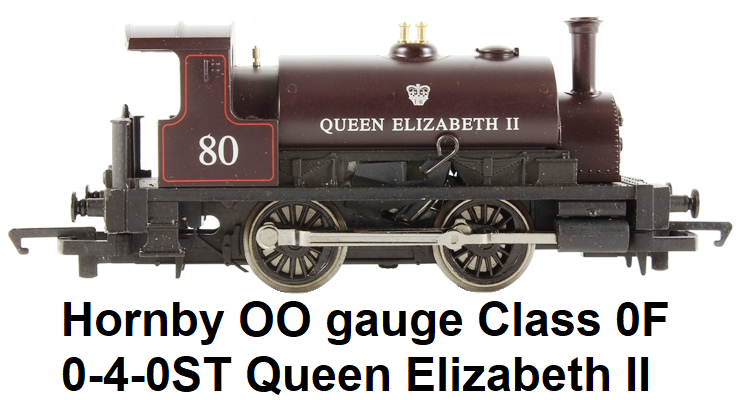 From 2015, Hornby plc began to announce a series of declining financial results. The major reason behind
the decline Hornby declared was twofold, with the decline in the number of (now aged, and hence older) collectable customers,
and a lack of interest in modelling as a hobby in light of the digitization and advancement of the internet games industry.
After the PLC shares dropped by more than 50% in a year, at the 2016 results Hornby declared that it planned to cut more than
half of the toys it made, after discovering that it generated 90% of its profits from only 50% of its range. In the year to
31 March 2017, revenues fell further to £47.4m from £55.8m, while underlying losses widened to £6.3m from a £5.7m deficit in
2016. The financial declines culminated in July 2017, when the largest shareholder Phoenix Asset Management (PAM) agreed to
buy 17.6 million Hornby shares for 32.375p from the second largest - and activist/protagonist shareholder - New Pistoia
Income (NPI), which gave PAM a 55.2% holding in the company. This triggered under stock exchange rules a mandatory takeover
offer of Hornby by PAM, at the NPI strike price of 32.375p, valuing Hornby at £27.4million. As a result of the takeover, the
chairman of Hornby resigned from the company in August 2017, followed by the Chief Executive in September 2017.
From 2015, Hornby plc began to announce a series of declining financial results. The major reason behind
the decline Hornby declared was twofold, with the decline in the number of (now aged, and hence older) collectable customers,
and a lack of interest in modelling as a hobby in light of the digitization and advancement of the internet games industry.
After the PLC shares dropped by more than 50% in a year, at the 2016 results Hornby declared that it planned to cut more than
half of the toys it made, after discovering that it generated 90% of its profits from only 50% of its range. In the year to
31 March 2017, revenues fell further to £47.4m from £55.8m, while underlying losses widened to £6.3m from a £5.7m deficit in
2016. The financial declines culminated in July 2017, when the largest shareholder Phoenix Asset Management (PAM) agreed to
buy 17.6 million Hornby shares for 32.375p from the second largest - and activist/protagonist shareholder - New Pistoia
Income (NPI), which gave PAM a 55.2% holding in the company. This triggered under stock exchange rules a mandatory takeover
offer of Hornby by PAM, at the NPI strike price of 32.375p, valuing Hornby at £27.4million. As a result of the takeover, the
chairman of Hornby resigned from the company in August 2017, followed by the Chief Executive in September 2017.
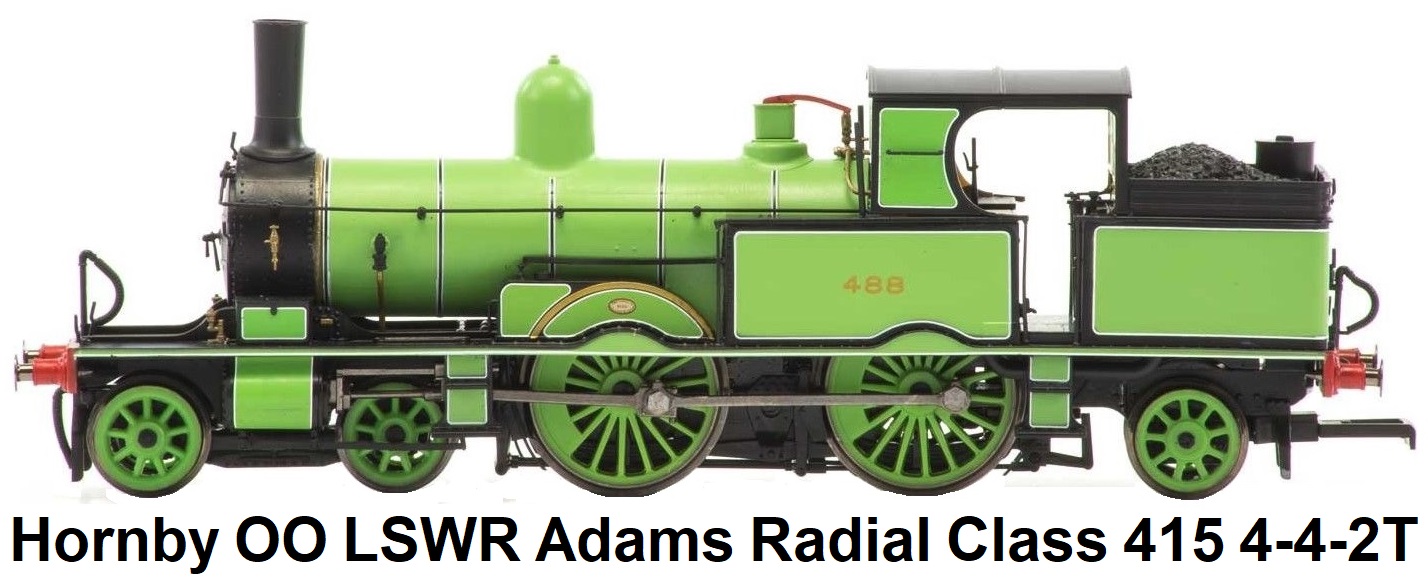 Hornby made 'O' gauge advertising wagons in the pre-war period that are highly desired by collectors today.
These include the Coleman's Mustard, Jacob's Biscuits, and Cadbury's Chocolates vans. Hornby's largest O gauge locomotive,
the Princess Elizabeth introduced in 1937 is also coveted by collectors and sells in near-mint condition in the original box
for over £2700. Pre-1964 Hornby trains have enjoyed a level of adult collector interest since the 1940's. In 1969 the Hornby
Railway Collector's Association was founded to cater for this and currently enjoys a membership approaching 3000, producing
10 journals a year, as well as other literature. Publications on older Hornby and Meccano products are dominated by those
published by New Cavendish Books as "The Hornby Companion Series", in particular Chris & Julie Graebe's "The Hornby Gauge O
System" and Michael Foster's sister volume on Hornby Dublo.
Hornby made 'O' gauge advertising wagons in the pre-war period that are highly desired by collectors today.
These include the Coleman's Mustard, Jacob's Biscuits, and Cadbury's Chocolates vans. Hornby's largest O gauge locomotive,
the Princess Elizabeth introduced in 1937 is also coveted by collectors and sells in near-mint condition in the original box
for over £2700. Pre-1964 Hornby trains have enjoyed a level of adult collector interest since the 1940's. In 1969 the Hornby
Railway Collector's Association was founded to cater for this and currently enjoys a membership approaching 3000, producing
10 journals a year, as well as other literature. Publications on older Hornby and Meccano products are dominated by those
published by New Cavendish Books as "The Hornby Companion Series", in particular Chris & Julie Graebe's "The Hornby Gauge O
System" and Michael Foster's sister volume on Hornby Dublo.
Hornby website
Hornby Railways Collector guide
Hornby Railway Collectors Association website
